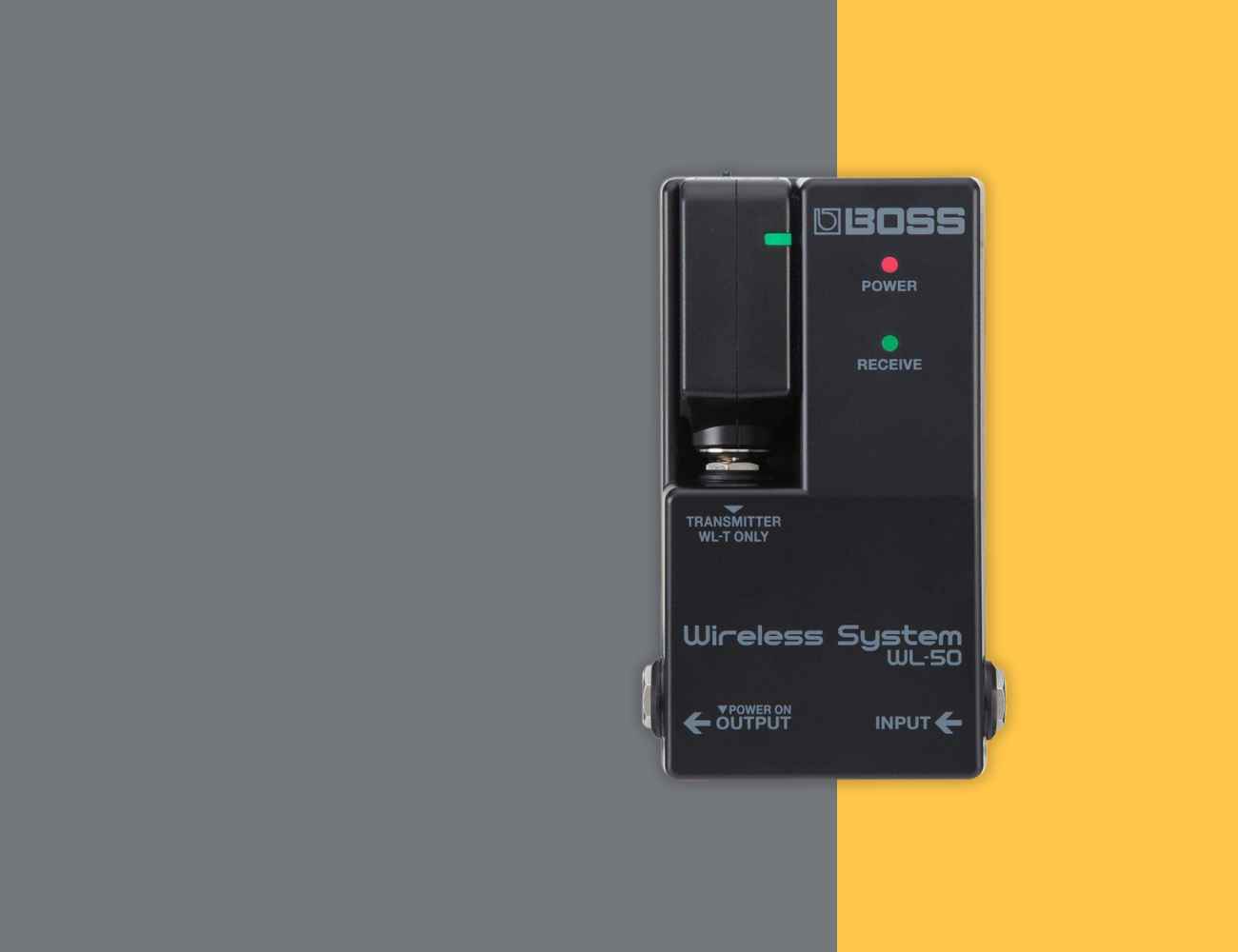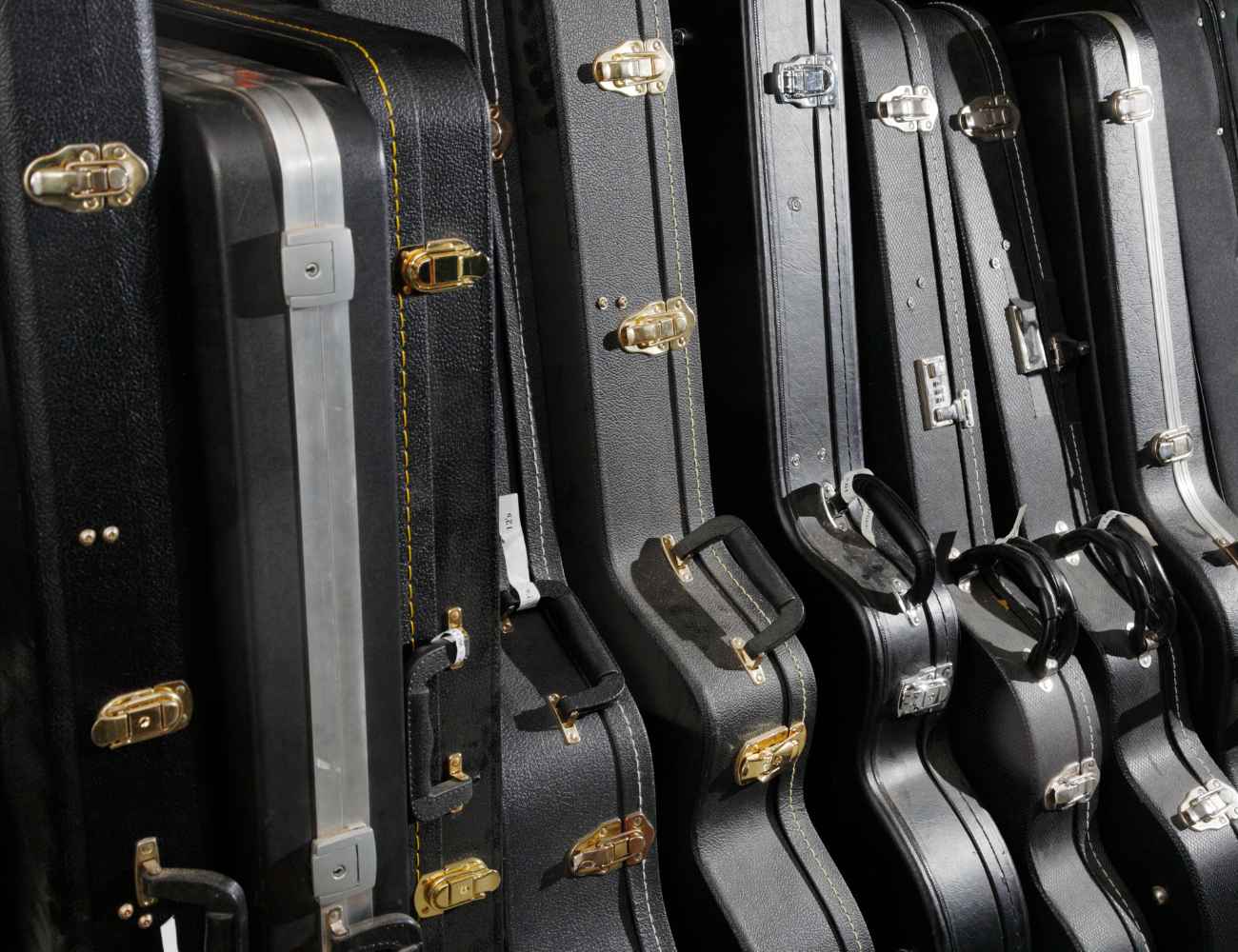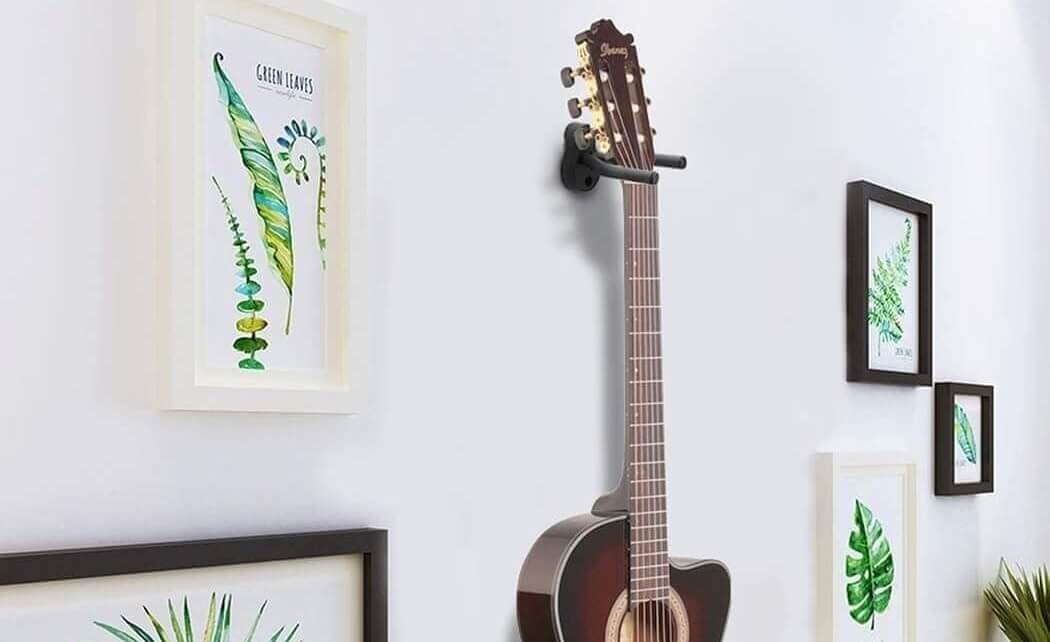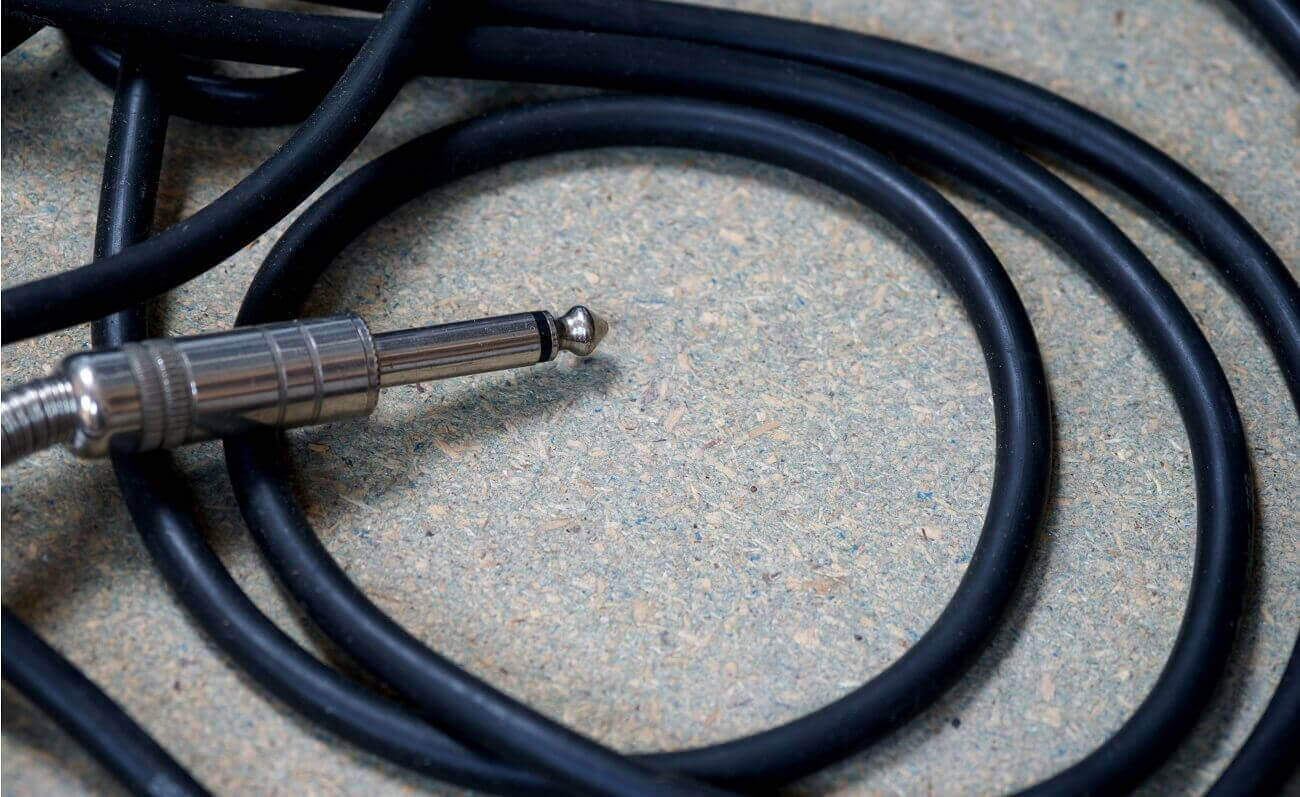Are you feeling chained to your amp while jamming on your guitar? We’ve all been there.
Enter the realm of guitar wireless systems, a game-changer for every guitarist looking to upgrade their gear.
You’ll agree that nothing kills the vibe faster than a tangled mess of guitar cables.
In this article, we’ll cover the best guitar wireless systems on the market, discussing freedom of movement, stellar sound quality, and wire-free convenience.
Whether you’re a stage performer, a garage band rocker, or a budding bedroom artist, this piece of tech is your ticket to an unhampered, high-quality musical experience.
Aside from that, we’ll also talk about what to look for when buying, and some tips to get the most out of your wireless system.
Table of Contents
- Best Guitar Wireless Systems
- NUX B-5RC Wireless Guitar System
- SWIFF High-Grade Electronic Guitar Wireless System
- Xvive U2 Guitar Wireless System
- NUX C-5RC 5.8GHz Wireless Guitar System
- LEKATO Wireless Guitar System
- Shure PGXD14 Digital Wireless System
- Boss WL-60 Guitar Wireless System
- LEKATO Wireless Guitar System 5.8
- Samson Airline 88x Guitar Wireless System
- Westshell 1 Key to Switch Wireless Guitar System
- Boss WL-20L Guitar Wireless System
- Getaria Upgrade 2.4GHZ Wireless Guitar System
- Westshell Guitar Wireless System
- 1Mii M2 Wireless Guitar System
- Line 6 Relay G10 Digital Guitar Wireless System
- Boss WL-50 Guitar Wireless System
- Line 6 Relay G30 Wireless Guitar System
- What is a guitar wireless system?
- Do you need a guitar wireless system?
- What to consider when choosing a guitar wireless system?
- How to set up a guitar wireless system?
- Do guitar wireless systems affect guitar tone?
Best Guitar Wireless Systems
Before I begin, here are my top selected choices:
Boss WL-60 Guitar Wireless System

Quick changes, 25-hour battery, secure attachment. Check Price
|
|
LEKATO Wireless Guitar System

LEKATO Wireless Guitar System: 70-channel, no-lag UHF audio with fast, simple recharging. Check Price
|
NUX B-5RC Wireless Guitar System
Wireless guitar system with auto-match, mute, and cable tone simulation for active/passive pickups.
This wireless system delivers crystal clear sound with no buzzing, humming, or high-pitched noise, and is compatible with active/passive electric guitar and bass, acoustic-electric guitars with piezo or magnetic pickup. With up to 9 hours of playing time and a 30 meters streaming distance, this system provides a convenient and reliable way to enjoy wireless playing.
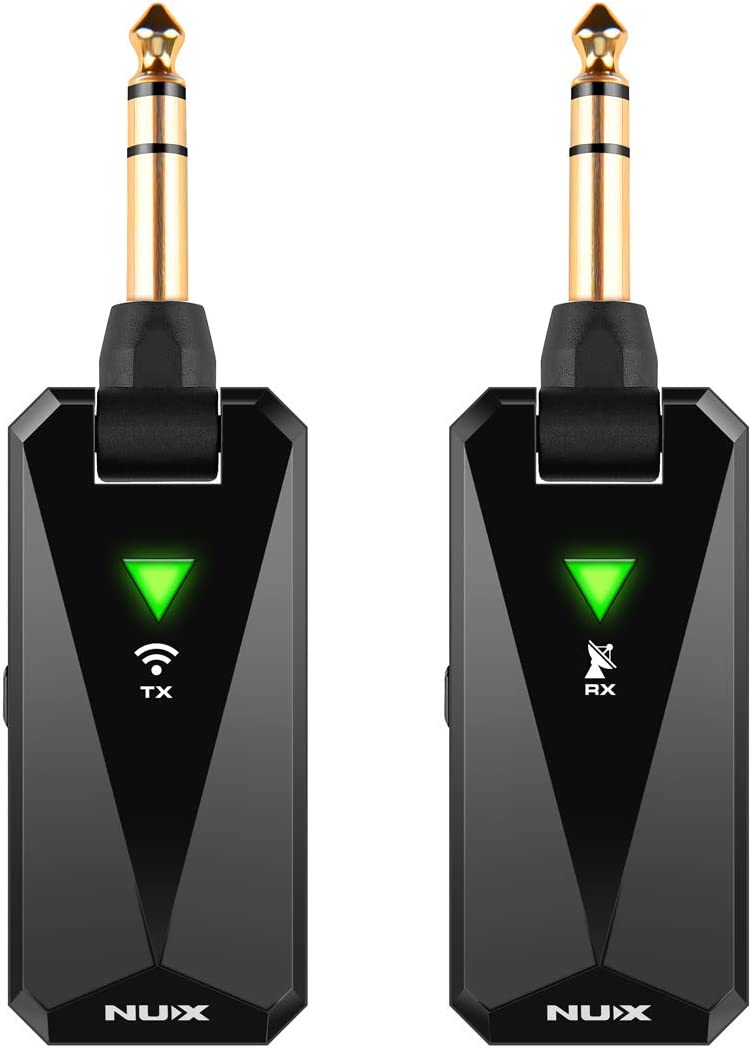
This device provides a wireless connection between your guitar and an amplifier.
It’s compatible with most guitar types, including active or passive pickups, but it might not be suitable for a Godin guitar.
The system leverages NUX’s signal processing algorithm to ensure a stable signal and ultra-low latency of less than 5ms, preserving your instrument’s natural tone and feel.
The set comes with a charging case, which provides a handy storage solution and offers around nine hours of battery life, enough to charge the system about three times.
The compact and lightweight design seamlessly fits any guitar body type.
One of the convenient features of this system is its auto-matching, eliminating the need for any manual setup.
It also has a mute function that can be activated by a short click on the transmitter’s power button.
A unique Cable Tone simulation feature is included to give you the natural sound of using a high-quality cable.
- My Review
Having had the pleasure to put the NUX B-5RC Wireless Guitar System to the test, I can confidently share my insights on its performance.
This system shines in its simplicity, with its plug-and-play setup making it a breeze.
There’s no need for fumbling around with complex configurations – it auto-matches and connects in seconds, saving precious time during practice or performances.
I found the signal quality to be exceptionally good.
The system leverages NUX’s advanced signal processing algorithm, ensuring a stable connection with ultra-low latency, less than 5ms.
This means that the nuances of your guitar’s tone and playing technique are preserved, making it feel like you’re using a traditional cable.
Speaking of cables, one feature that impressed me was the Cable Tone simulation.
It gives the sound warmth and character, reminiscent of a high-quality guitar cable.
It’s a subtle touch that I believe many musicians will appreciate.
The compact design of the transmitter and receiver was another highlight.
They’re light and unobtrusive, fitting seamlessly onto different guitar body types without hindering my playing.
On the downside, I did find that the system isn’t compatible with all guitar types – specifically, it didn’t work as well with my Godin guitar.
Battery life is also worth mentioning.
With the charging case, I could play for about 9 hours before needing a recharge.
In addition, the case can charge the system up to three times, which is quite handy.
One minor quibble I had was with the mute function.
Here are the ratings I’ll give to the NUX B-5RC Wireless Guitar System:
It’s activated by a short click on the power button of the transmitter, which can sometimes be accidentally triggered during play.
All in all, the NUX B-5RC Wireless Guitar System proved to be a reliable, high-quality product that offers an excellent balance of performance,
- Pros:
- Crystal-clear audio with low latency.
- Auto-matching system, no setup required.
- Mute function for short breaks.
- Compact and light-weight design.
- Charging/carrying case included.
- Cons:
- Range limitations, may cause dropouts or lag.
- May require an adapter cable for certain pickups.
- May experience static or signal loss in some environments.
- Short battery life, may require multiple sets for gigs.
- Transmitter may not be durable enough for regular use.
My final verdict is that the NUX B-5RC Wireless Guitar System is a solid choice for guitar and bass players who want a compact and reliable wireless system.
It offers several useful features, such as auto-matching, cable tone simulation, and mute function.
The product has received mostly positive customer reviews, highlighting its clear and stable signal, low latency, and original tone.
The charging case is also handy, providing up to 9 hours of battery life and protecting the system during transport.
However, some customers have reported issues with the product’s battery life, durability, and compatibility with certain pickups, which should be considered.
Overall, the NUX B-5RC offers a good balance of versatility, features, tone, performance, brand, and value, making it a strong contender in the wireless guitar system market.
SWIFF High-Grade Electronic Guitar Wireless System
Wireless UHF tech, 164ft range, rechargeable 5+ hrs battery.
The WS-50 Blackwing Digital Wireless System is a durable and reliable device providing a transmission distance of 164ft/50m and a battery life of 5+ hours. It features a high sampling rate (24bit/48khz) and multiple channels for simultaneous use without interference.
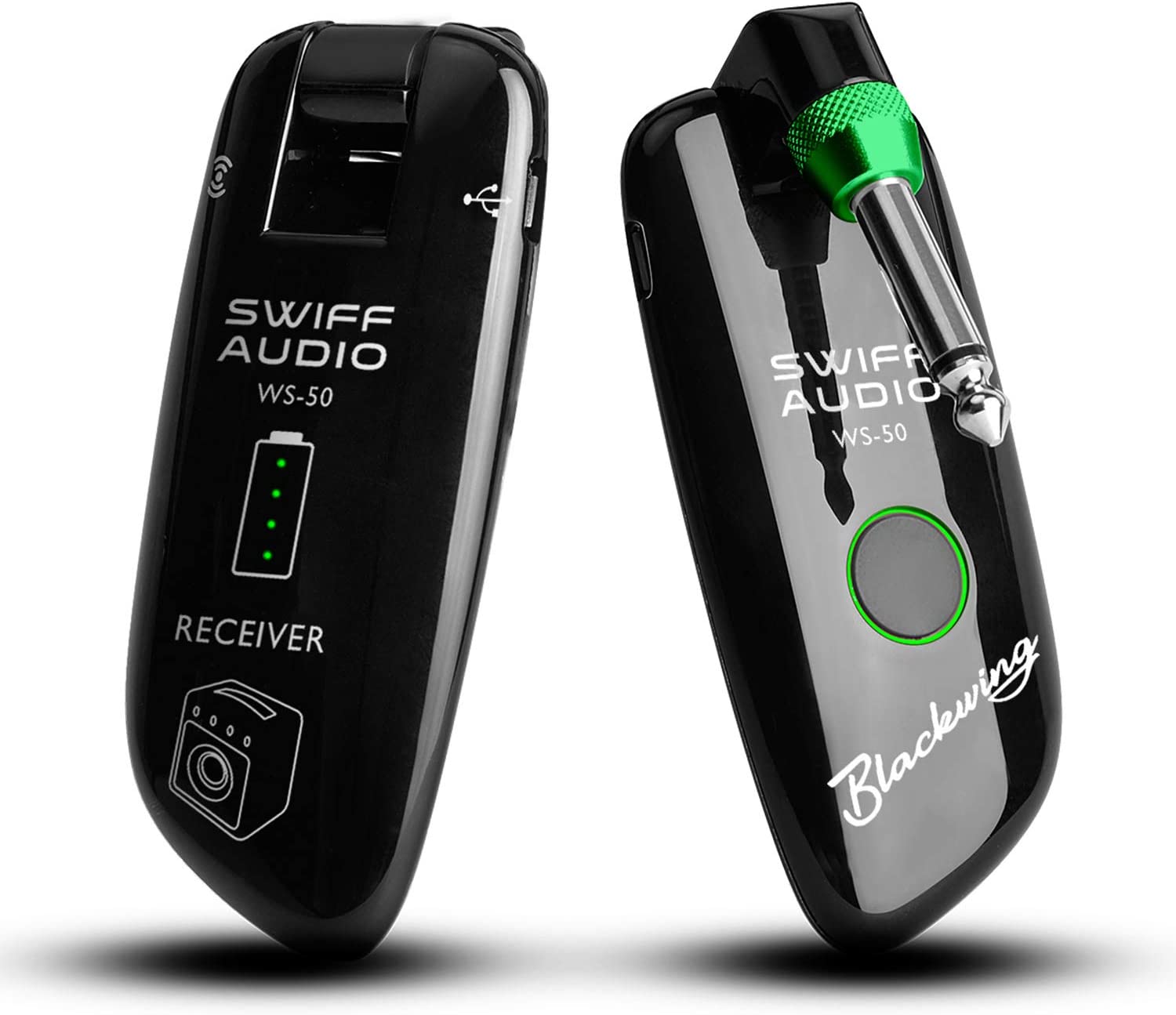
This SWIFF electronic guitar wireless system is a high-quality device that suits all electric musical instruments.
It leverages cutting-edge UHF frequency transmission technology and offers features like a power display and quick charging.
It’s particularly known for its long-range transmission, achieving a range of up to 164ft without signal loss, thanks to its 24bit/48kHz sampling frequency and 30-16KHz frequency response range.
As a bonus, this system supports multiple devices simultaneously with separate transmission channels for each, avoiding any interference.
It houses a durable rechargeable lithium battery lasting over 5 hours on a single charge, with a power indicator on the back.
Ease of use is another standout feature: the 220° rotatable plug simplifies pairing, and compatibility with the popular 6.35mm jack expands its usage across most electric musical instruments.
A corded electric or battery-powered option provides versatility in power sources.
It comes in black, with a Micro USB charging cable included.
- My Review
In my experience with the SWIFF electronic guitar wireless system, I have found it to be an invaluable tool for any musician.
Its UHF frequency transmission technology ensures clear sound transmission, which is important when performing or recording.
In addition, I was astounded by its range – a staggering 164ft without any signal loss.
The audio quality remains impeccable, owing to its 24bit/48kHz sampling frequency and 30-16KHz frequency response range.
A noteworthy aspect is its ability to support multiple devices simultaneously on separate transmission channels, which I found incredibly useful during band practices.
There was no interference or mix-ups, just smooth, clear sound from every instrument.
Its design is sleek and practical, with a durable rechargeable lithium battery that impressively lasts over five hours on a single charge.
In addition, I appreciated the power indicator on the back – a small but significant detail for keeping track of battery life during performances.
One of the standout features for me was the 220° rotatable plug.
It made pairing the device a breeze and added a layer of convenience I hadn’t expected.
Its compatibility with the 6.35mm jack is an added benefit, making this system versatile and adaptable to different instruments.
As for power options, it offers both corded electric and battery-powered options.
I would switch to the corded option for longer sessions to save the battery.
This flexibility was a welcome feature.
In terms of aesthetics, its black color adds a professional touch, and the included Micro USB charging cable is a thoughtful addition.
Despite its numerous benefits, I noticed it took a while to charge, which could be an issue for some fully.
Here are the ratings I’ll give to the SWIFF High-Grade Electronic Guitar Wireless System:
However, considering its performance and versatility, this minor drawback does not overshadow its merits.
The SWIFF electronic guitar wireless system is a reliable, high-quality tool for any musician.
- Pros:
- Long transmission range
- Supports multiple devices
- Simple to use and setup
- High sampling rate
- Durable rechargeable battery
- Cons:
- May add slight hiss or compression
- Occasional dropouts and interference
- No USB-C charging port
- Plastic build quality feels cheap
- May not work well with all instruments
My final verdict is that the SWIFF High-Grade Electronic Guitar Wireless System is a reliable, cost-effective wireless system with excellent features and performance.
Its long battery life, wide transmission range, and ability to support multiple devices simultaneously without interference make it a great choice for musicians looking to go wireless.
While minor drawbacks, such as the micro USB connection and occasional dropouts, the system’s overall value, ease of use, and convenience make it a solid investment for home and professional use.
Xvive U2 Guitar Wireless System
Xvive’s U2 Guitar Wireless System delivers no-compromise, no-lag, no-interference audio for instruments with passive pickups.
The Xvive U2 system provides up to 120 feet of wireless range, four channel choices, and a response from your instrument that is very similar to what you’re used to from a cable. Its compact size, flexibility, and rechargeable battery make it a practical and hassle-free solution for guitarists, bassists, and other musicians. Additionally, it broadcasts on the 2.4GHz band to avoid interference and can be used with multiple instruments and amps.
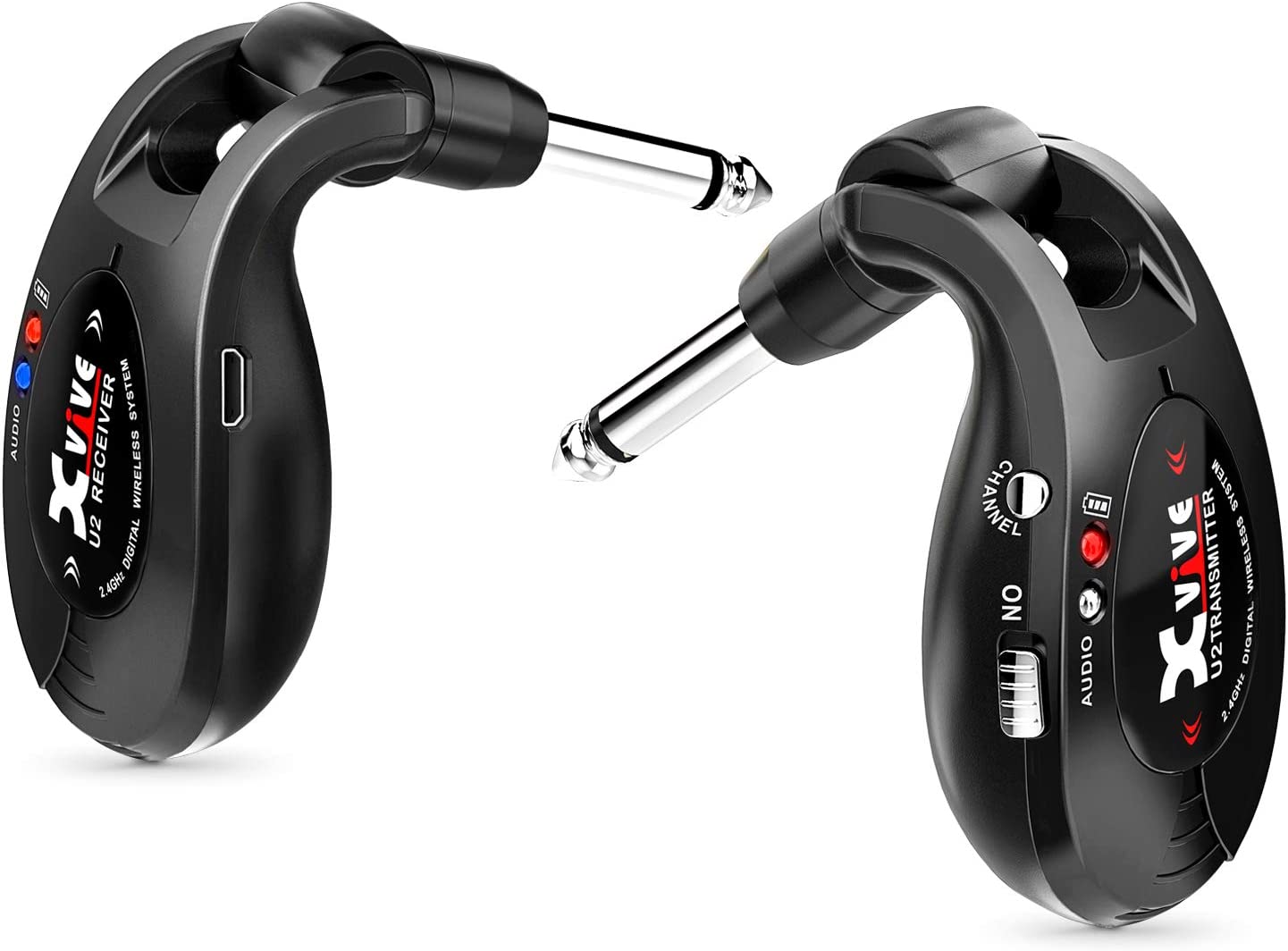
This equipment is a game-changer for musicians, especially those who play electric guitar, bass, keyboard, or violin.
It operates on a 2.4GHz frequency, ideal for clear, low-latency sound transmission.
A notable feature is its rechargeable lithium battery that provides up to five hours of use on a full charge.
For easy charging, it includes a USB cable, similar to the ones you use for your mobile devices.
This wireless system boasts excellent range – around 90 feet outdoors, even through walls.
Its 220° rotatable plug design suits various musical instruments with pickups, making it versatile.
Additionally, it can broadcast simultaneously on four channels, allowing for flexible configurations.
A standout aspect is its simplicity – plug it in, power it up, sync the transmitter and receiver, and you’re good to go!
Its compact size makes it perfect for travel and easy storage.
- My Review
I’ve enjoyed using the Xvive U2 Guitar Wireless System in several settings.
One thing that immediately stood out to me was the convenience it brings.
Being free from the restrictions of wired connections was liberating as a musician.
I moved around my performance space without feeling tied down, and the range was impressive.
At about 90 feet outdoors, I felt no signal loss, even with walls in the way.
The sound quality was another area where this system shined.
It operates on a 2.4GHz frequency, ensuring a low-latency, high-quality sound transmission.
As a result, my guitar’s tone was clear and intact, almost indistinguishable from a wired connection.
Charging this system was a breeze with its USB compatibility.
In addition, I appreciated that the battery was built to last, with up to five hours of playtime on a full charge.
It meant I could use it for extended gigs or practice sessions without worrying about the battery dying midway.
The Xvive U2 also proved its worth in terms of versatility.
Its 220° rotatable plug design made it compatible with various instruments, from my electric guitar to my keyboard.
It was also capable of simultaneous broadcasts on four channels, which came in handy with multiple instruments.
However, I found a minor drawback.
There were occasional brief signal dropouts in areas with much wireless activity.
But these were few and far between and didn’t significantly impact my overall experience.
Here are the ratings I’ll give to the Xvive U2 Guitar Wireless System:
In my experience, the Xvive U2 Guitar Wireless System is a robust, reliable tool that offers both freedom of movement and exceptional sound quality.
Despite a minor hiccup in high wireless traffic areas, it’s an investment I would recommend to any musician looking for a hassle-free wireless solution.
- Pros:
- 2.4GHz band for clear signal transmission
- Less than 5ms latency
- Built-in rechargeable lithium battery
- Easy plug and play setup
- Good range and sound quality
- Cons:
- May have interference from Wi-Fi and Bluetooth
- Active pickups may require an additional transmitter holder
- May cause a noticeable change in tone compared to using a cord
- May have issues with fit and popping sounds for some acoustic guitars
- May require additional patch cables and adapter for some setups
My final verdict is that the Xvive U2 Guitar Wireless System is a great choice for musicians who want the freedom of wireless playing without sacrificing sound quality.
The system’s 2.4GHz band and four channels provide clear transmission and avoid interference, and its rechargeable battery lasts up to 5 hours.
While some reviewers have reported occasional interference and reduced range, most users have found the Xvive U2 reliable and effective.
With its ease of use, solid construction, and affordable price point, the Xvive U2 Guitar Wireless System is a solid investment for any musician looking to go wireless.
NUX C-5RC 5.8GHz Wireless Guitar System
High performance digital signal, plug & play, auto-matching system with MUTE function.
This digital wireless guitar system provides a fast-matching plug & play connection between instrument and amp with no setup required. The unique auto-matching system and MUTE function make it easy to quickly start and stop playing.
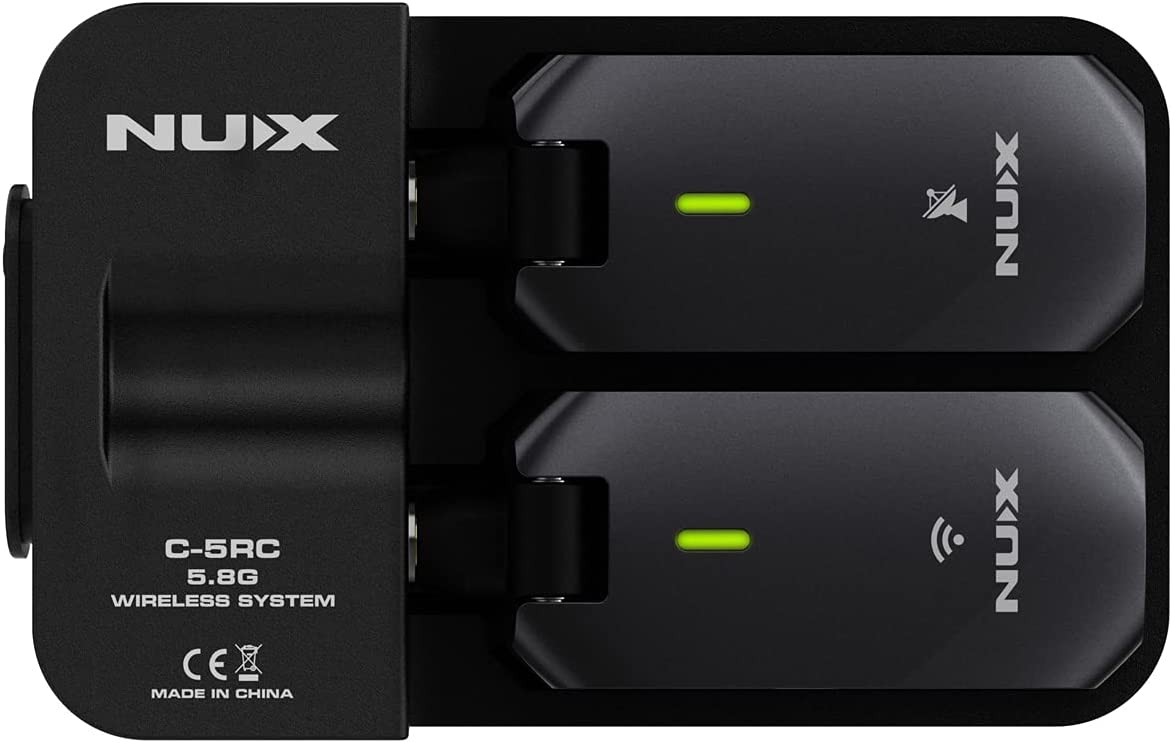
This compact, black device is specially designed to cater to the needs of both active and passive pickup guitars.
Its compatibility stretches to Electric Guitars, Acoustic-electric Guitars, Bass Guitars, and Ukuleles.
Utilizing a 5.8GHz band, it stands out with minimal interference, providing an uninterrupted experience whether you’re playing at home or on stage.
One of its standout attributes is the 24-bit 44.1 kHz audio quality, ensuring you don’t lose tonal quality during your performance.
In addition, an important part of its design is the Auto-Matching System and a MUTE function for pausing your performance.
Another notable feature is the Cable Tone Simulation, which helps maintain a low latency of less than 5ms.
This device has dimensions measuring 5.4 x 2 x 2.3 inches, powered by 9 Volts and 5 Milliamps.
It runs on electricity and works with an analog signal format.
One of its biggest conveniences is the inclusion of a portable Power Case for on-the-go charging.
It’s a simple plug-and-play device that sets up quickly through its unique Auto-Matching System.
- My Review
Having spent considerable time with the NUX C-5RC 5.8GHz Wireless Guitar System, I can confidently say it offers a lot to musicians.
Right off the bat, it’s worth mentioning that the device is compatible with a diverse range of string instruments.
Whether you’re a guitarist or a ukulele player, this system easily caters to active and passive pickups.
A particular advantage I appreciated was its 5.8GHz frequency band.
It’s a relief to play on stage or at home without worrying about interference from other devices.
However, it’s not all smooth sailing.
I noticed the unit produced a high-frequency noise when used with active pickups under certain circumstances.
This was particularly evident when the receiver was near the guitar’s control cavity, and it’s something potential buyers should be aware of.
One feature I found particularly useful was the Auto-Matching System.
It’s so simple and convenient to use; power up both devices, plug the transmitter into your instrument and the receiver into your amp – voila, you’re ready to go.
There’s also a MUTE function, a thoughtful addition for those moments when you need to pause your performance.
As for audio quality, the 24-bit 44.1 KHz audio is impressive, ensuring no unwanted sound degradation.
That said, the system does add a slight compression to the signal.
While this may be noticeable for some, it subtly enhances the presence in the mix, particularly for lead players.
The device does have a sleep mode feature that can prove inconvenient.
If there’s no activity for about 10 minutes, it switches off automatically.
While this could be a deal-breaker for some, particularly those playing multiple instruments, it didn’t bother me much.
Lastly, the portable Power Case is a brilliant addition.
It eliminates the worry of running out of charge, particularly during long practice sessions.
However, the rubber disk, intended to protect your instrument’s finish, seems misplaced and doesn’t serve its purpose.
Here are the ratings I’ll give to the NUX C-5RC 5.8GHz Wireless Guitar System:
Despite a few hiccups, my experience with the NUX C-5RC was predominantly positive.
It’s a reliable and convenient tool for musicians, delivering quality sound and a degree of freedom that’s hard to resist.
- Pros:
- Low interference in 5.8GHz band
- Fits with all types of guitars
- Comes with a portable charging case
- 24-bit 44.1 KHz audio quality
- Auto-matching system and MUTE function
- Cons:
- High frequency noise with active pickups
- May not work well with some instruments
- May have occasional drop-outs
My final verdict is that the NUX C-5RC 5.8GHz Wireless Guitar System is a versatile and feature-packed wireless system that offers good value for its price.
The product’s compatibility with various guitars and pickups, auto-matching systems, and cable tone simulation features make it a convenient and versatile option for musicians.
The portable charging case is also a useful addition that makes it easy to charge wireless units.
While some users have reported minor limitations with audio quality and occasional dropouts, overall, the product performs well with minimal interference.
Based on the available information, I recommend this product to musicians looking for a reasonable price for a reliable and versatile wireless guitar system.
LEKATO Wireless Guitar System
LEKATO Wireless Guitar System: 70-channel, no-lag UHF audio with fast, simple recharging.
This LEKATO Wireless Guitar System provides a reliable and fast connection with no latency, allowing musicians to perform freely. It’s easy to set up and the rechargeable lithium battery offers a long working time. Perfect for musicians who want to make their instrument wireless.
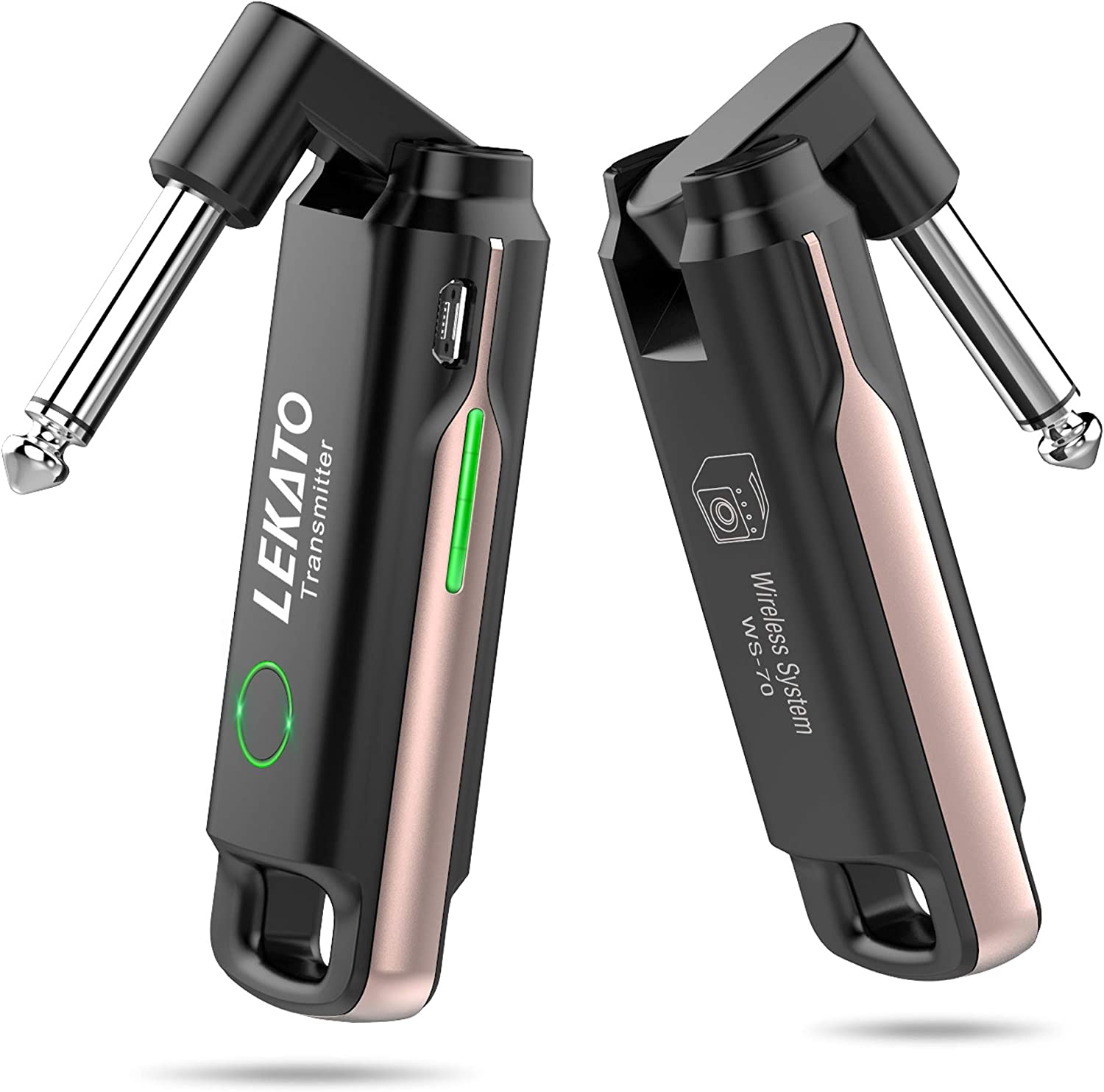
The LEKATO Wireless Guitar Transmitter Receiver is a high-quality system designed to make your electric instruments, such as guitars and basses, wireless for a more liberating playing experience.
This system has 70 channels, allowing up to 70 sets of instruments to operate simultaneously without interference.
In addition, one transmitter can connect to four receivers at once, making it perfect for live performances.
This wireless system utilizes advanced UHF technology for clear audio quality and stable signal transmission, with a latency of less than 3ms.
It is also designed for easy use—press the signal key to sync the transmitter and receiver.
The system works well with most electric guitars, basses, electric-acoustic guitars, and other popular instruments with pickups.
The built-in rechargeable lithium battery provides over 4.5 hours of use, depending on your usage.
In addition, the system comes with a dual-ended USB cable for easy charging.
With a full 20 Hz-20 kHz frequency response, this wireless guitar system offers excellent sound quality for various instruments.
Note, however, that it is not recommended for battery-powered guitars.
- My Review
My experience with the LEKATO Wireless Guitar Transmitter Receiver was a game-changer for my live performances.
With 70 channels, I could connect up to four receivers from a single transmitter, allowing seamless collaboration with other musicians on stage.
While using this system, I noticed that it employs advanced UHF technology, which impressed me with its clear audio quality and ultra-low latency of less than 3ms.
Furthermore, this technology ensures no lag or signal loss, which is crucial during live performances.
Also, its strong anti-interference ability helped me deliver the best of my music without any hiccups.
One unique attribute I appreciated is the ease of use; it only took a long press of the signal key to match the transmitter and receiver.
This plug-and-play feature saved me time and unnecessary fiddling with equipment.
Being a rechargeable system, it offered more than 4.5 hours of playtime.
Although the battery life was not as long as some might desire, I found it sufficient for my regular gigs.
In addition, the dual-ended USB cable included for recharging proved to be a convenient feature.
The system offered a complete frequency response from 20 Hz to 20 kHz, giving my music a full-bodied sound.
However, I noticed a subtle change in the tone compared to a traditional cable connection – it seemed to have less treble, which I found more pleasing to the ear.
Here are the ratings I’ll give to the LEKATO Wireless Guitar System:
Although it was great with my electric and electric-acoustic guitars, I found it unsuitable for battery-powered guitars.
But considering its performance with other instruments, I still found the LEKATO Wireless Guitar Transmitter Receiver to be a solid investment for anyone looking to go wireless with their guitar setup.
- Pros:
- 70 channels
- Clear audio quality
- Convenient charging
- Wide compatibility
- Easy plug and play
- Cons:
- Possible tonal difference compared to cable
- Audibly less sustain compared to cable
- May produce inherent noise gate effect
- Signal may cut out if moving around
- Battery life may not last as long as advertised
My final verdict is that the LEKATO Wireless Guitar Transmitter Receiver is a great product for its price.
It offers many useful features, such as 70 channels, clear audio quality, easy plug-and-play, and convenient charging.
It is compatible with various electric instruments without cell phones or WiFi interference.
The product has some drawbacks, such as the possible tonal difference compared to cable, audibly less sustain than cable and a battery life that may not last as long as advertised.
However, it is a versatile and reliable product that provides excellent value for money.
Shure PGXD14 Digital Wireless System
Rock-solid RF signal, 24bit/48kHz digital audio, hassle-free setup.
Shure’s PGXD4 wireless system provides digital audio clarity and reliable RF signal, with a bodypack transmitter featuring adjustable gain and a WA302 instrument cable for connecting a 1/4″ jack. Perfect for musicians looking for hassle-free setup and clear sound quality.
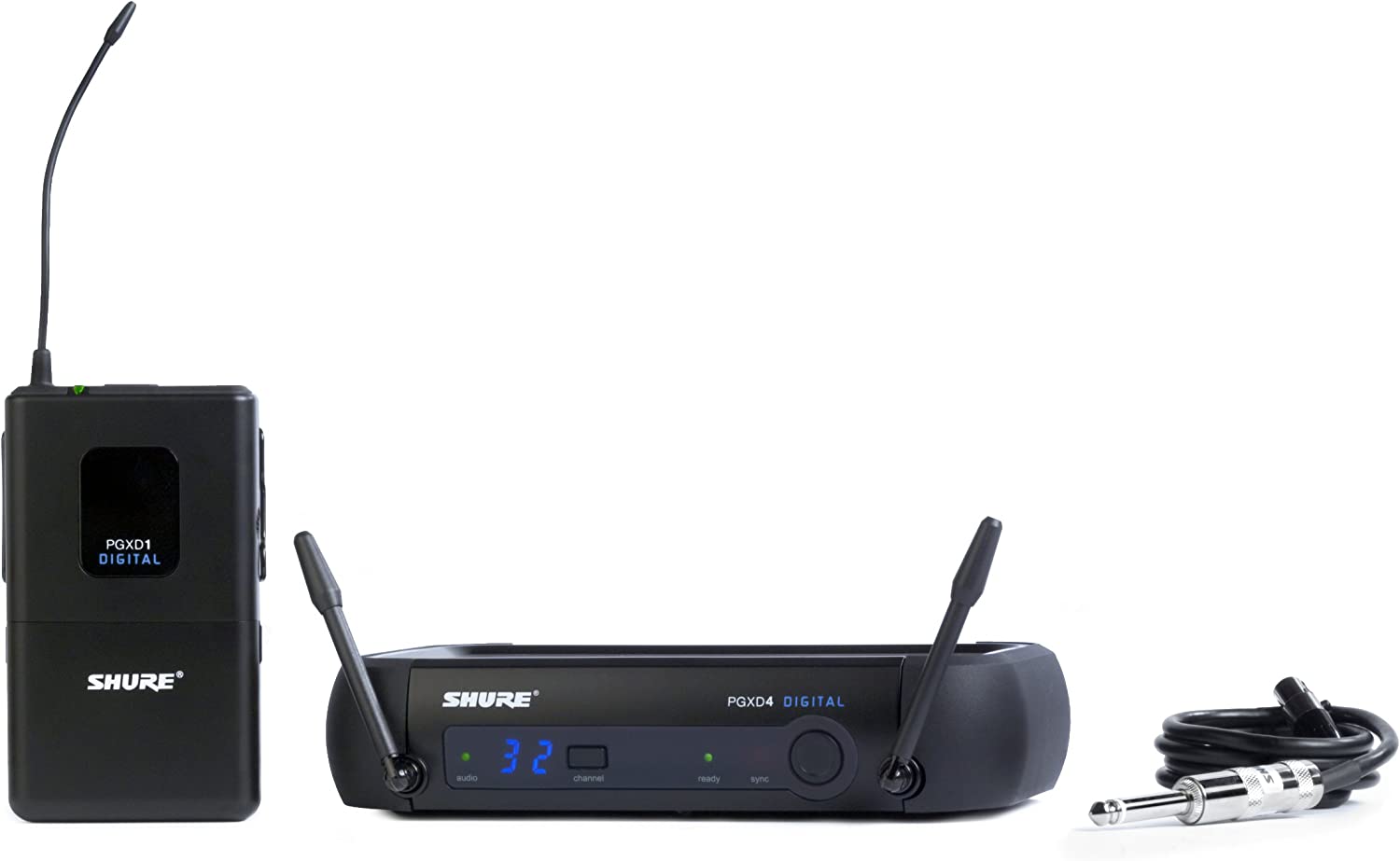
This is a highly versatile device, perfect for musicians who switch between various instruments, such as guitars and basses.
The PGXD1 bodypack transmitter, conveniently attached to your belt or guitar strap, offers a broad frequency range of 20Hz – 20kHz. It’s designed to operate for up to 10 hours on just two AA batteries and provides a generous 200 feet of wireless freedom.
On the other end, you’ll find the PGXD4 receiver, which delivers high-quality sound with its 24-bit/48kHz audio technology.
It also features auto frequency selection and true digital diversity for robust reliability.
This receiver’s ability to provide clear, wired-like audio in a wireless format makes it stand out.
Additionally, this system comes with a WA302 instrument cable.
It connects to any 1/4-inch line-level instrument output, such as guitars or basses.
The system is designed by Shure, a brand known for its reliable microphones and audio equipment.
It’s black and comes with a battery included.
It weighs only 0.05 pounds and has dimensions of 17.5 x 12.5 x 4 inches, making it portable and convenient to carry around.
- My Review
After spending quality time with the Shure PGXD14 Digital Wireless System for Guitar/Bass, I’ve come to appreciate its many features and overall functionality.
First, the PGXD1 body pack transmitter stands out for its durability and efficiency.
Second, I found it incredibly convenient to clip it onto my belt or guitar strap, allowing me to move around on stage without worrying about cables.
As a musician who values sound quality, the 20Hz – 20kHz frequency range provided by this wireless system did not disappoint.
I observed no significant difference between the wireless and wired sound, which was impressive.
Plus, the generous 200 feet range allowed me to roam further while performing.
The PGXD4 receiver’s 24-bit/48kHz accurate sound was another aspect I truly appreciated.
Its automatic frequency selection simplified the setup process and added reliability, ensuring a strong, clean RF performance.
The true digital diversity, with two antennas and two independent receivers, provided a rock-solid RF signal, enhancing my confidence during performances.
I also found the WA302 instrument cable very useful.
Being able to plug into any 1/4-inch line-level instrument output was a valuable feature, especially when switching between instruments.
However, it wasn’t all perfect. The gain control on the bodypack transmitter was tricky to adjust.
Finding the sweet spot between clean and dirty tones without causing feedback was challenging.
Also, I found the 2.5 ft length of the instrument cable to be somewhat limiting, especially when playing instruments like the fiddle.
Here are the ratings I’ll give to the LEKATO Wireless Guitar System:
Despite these minor drawbacks, I found the Shure PGXD14 reliable, efficient, and high-quality wireless system.
It’s a solid choice for any musician, whether playing in small venues or larger stages.
- Pros:
- Excellent sound quality.
- Rugged and durable body pack transmitter.
- Easy to set up and use.
- Good battery life.
- No interference issues.
- Cons:
- Cable length may not be suitable for all instruments.
- Gain control can be touchy.
- Receiver construction may feel cheap.
- Some reviewers experienced delay or signal dropouts.
My final verdict is that the Shure PGXD14 Digital Wireless System for Guitar/Bass is a solid choice for musicians seeking a reliable and affordable wireless system.
The product offers the excellent sound quality, reliable RF signal, true digital diversity, and easy setup and operation.
While there were concerns regarding cable length, gain control, and receiver construction, the overall positive reviews indicate that the product is a good value for the price.
Based on the information, the Shure PGXD14 Digital Wireless System for Guitar/Bass is recommended for musicians looking for a wireless performance system.
Boss WL-60 Guitar Wireless System
Quick changes, 25-hour battery, secure attachment.
The Boss WL-60T Wireless Transmitter is designed for compatibility with the WL-60 Wireless System, allowing quick instrument changes on stage. With up to 25 hours of runtime on two AA batteries, it features an LED display for power status and easy channel assignment. The adjustable clip and included high-quality short cable ensure secure attachment and versatile instrument connection.
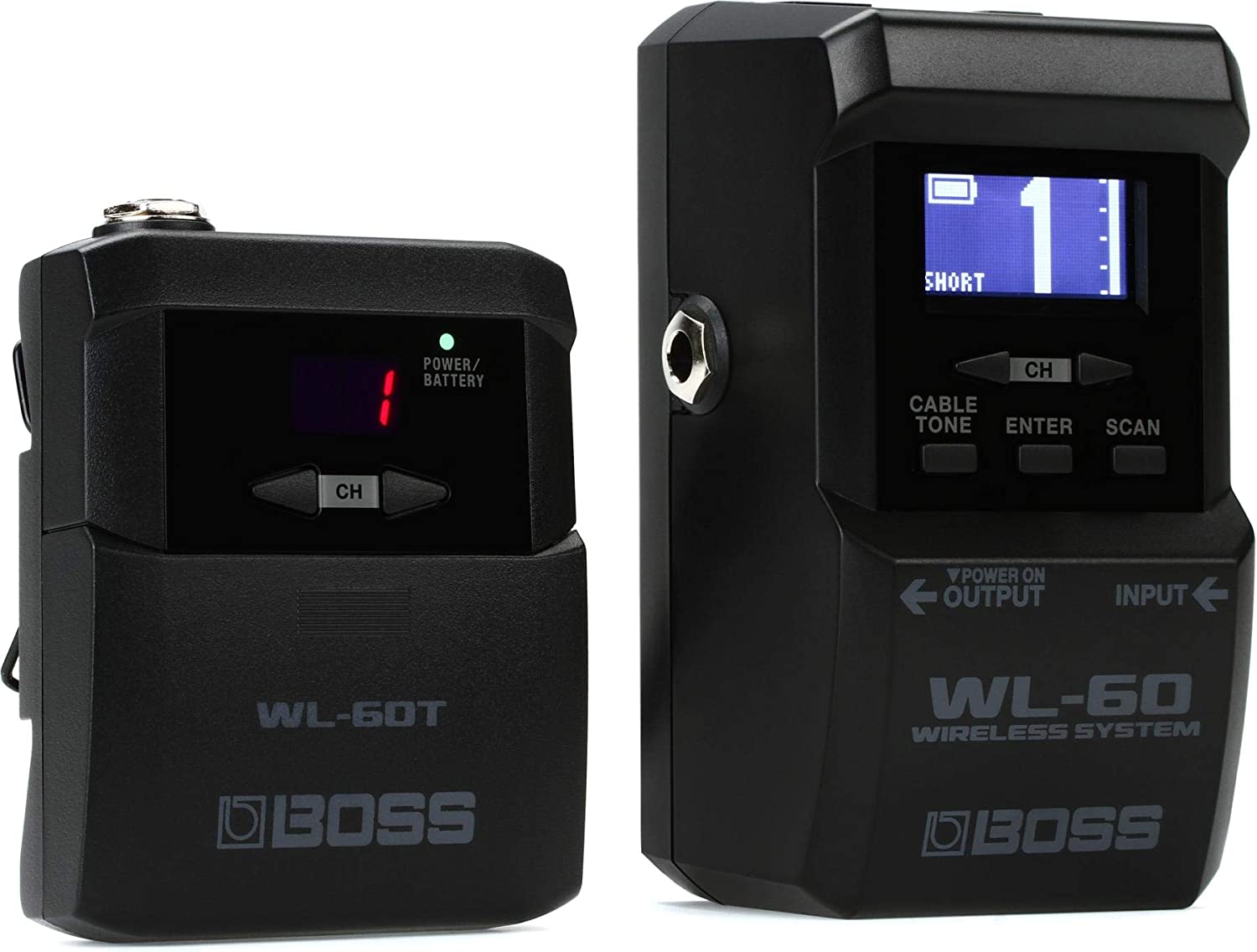
Let’s dive into the details of the Boss WL-60 Guitar Wireless System.
First, this plug-and-play wireless system is purposely designed with a compact footprint to blend into your pedalboard setup seamlessly.
In addition, it boasts a 65′ operating range and 14 channel options, providing impressive flexibility and mobility.
Manufactured by BOSS, renowned for its innovative music gear, the WL-60 is more than just a wireless system.
One feature that stands out is its easy-to-read display and direct-access buttons, simplifying the process of scanning and selecting the best wireless channel.
With these, you can achieve the perfect setup in no time, even on a dimly lit stage.
Another noteworthy point is the WL-60’s bodypack transmitter, designed for almost any instrument.
Despite its rugged construction, it delivers up to 25 hours of performance using regular alkaline batteries.
The complete package has a user manual and requires two AA batteries.
The system is also battery-powered, making it a great portable option.
Interestingly, this model is finished in a sleek black and features a unidirectional polar pattern.
Weighing a modest 1.36 pounds, it measures 7.05 x 6.55 x 3.25 inches, ensuring it won’t dominate your pedalboard space.
- My Review
As a musician always looking for tools that simplify my stage setup, the Boss WL-60 Guitar Wireless System has caught my attention.
Right out of the box, the plug-and-play design is a refreshing change, making integrating this system into my existing pedalboard setup effortless.
Switching between 14 channels and covering a 65-foot range gave me a new level of freedom on stage.
I also admired the compactness of the receiver, a feature that will undoubtedly appeal to performers who value pedalboard real estate.
The large visual display is a practical addition, making channel selection and scanning intuitive, even under low-light conditions.
I genuinely appreciate the WL-60 system’s transmitter’s compatibility with various instruments.
With its impressive battery life of up to 25 hours, this versatility allows for uninterrupted performances.
However, it’s not without its flaws.
For instance, I was taken aback by the transmitter and receiver’s plastic housing.
Given Boss’s reputation for sturdy, metal-encased gear, this felt like a step back in durability.
The transmitter presented two main issues.
Firstly, its battery cover tended to fall off too easily, which could disrupt performance.
Secondly, the design makes switching instruments quickly during live performances hard.
The transmitter attaches to the guitar strap, so I had to remove the strap entirely to swap instruments, a considerable inconvenience during a live set.
Despite these criticisms, the WL-60 remains a powerful tool.
Here are the ratings I’ll give to the Boss WL-60 Guitar Wireless System:
Its easy setup, strong signal, and user-friendly features offer a lot to serious musicians, even if some design choices might need rethinking for the next iteration.
While it might not be perfect, it’s a solid addition to my arsenal of stage equipment, and I’m sure many other performers would feel the same.
- Pros:
- Long operating range (65′)
- Easy plug-and-play setup
- Large visual display on receiver
- Fast user-guided control
- Compatible with most instruments
- Cons:
- Plastic housing (not metal)
- Battery cover on transmitter falls off easily
- Transmitter cannot be quickly unclipped from strap
- Interference or signal drops reported by some users
My final verdict is that the Boss WL-60 Guitar Wireless System is a great option for musicians who value ease of use and portability, as it offers a plug-and-play setup and a compact size.
It has a strong signal and a long operating range, making it suitable for serious stage performers.
The receiver features a large visual display and direct-access buttons for quick and easy scanning and selecting the best wireless channel.
However, some users have reported issues with the plastic housing, battery cover, and signal drops.
Considering the features, brand reputation, and price point, the Boss WL-60 Guitar Wireless System is a good value for those who need a reliable wireless system for their performances.
LEKATO Wireless Guitar System 5.8
Premium 5.8Ghz wireless guitar system, no lag or signal loss, easy to use.
LEKATO’s Best Wireless Guitar System is designed to provide high quality, no-lag sound with a 100 meter transmission distance. Easily switch channels with the matching button on the receiver, and charge for 10 minutes to activate the battery. Strong interference may cause strange noise, but can be solved by switching channels.
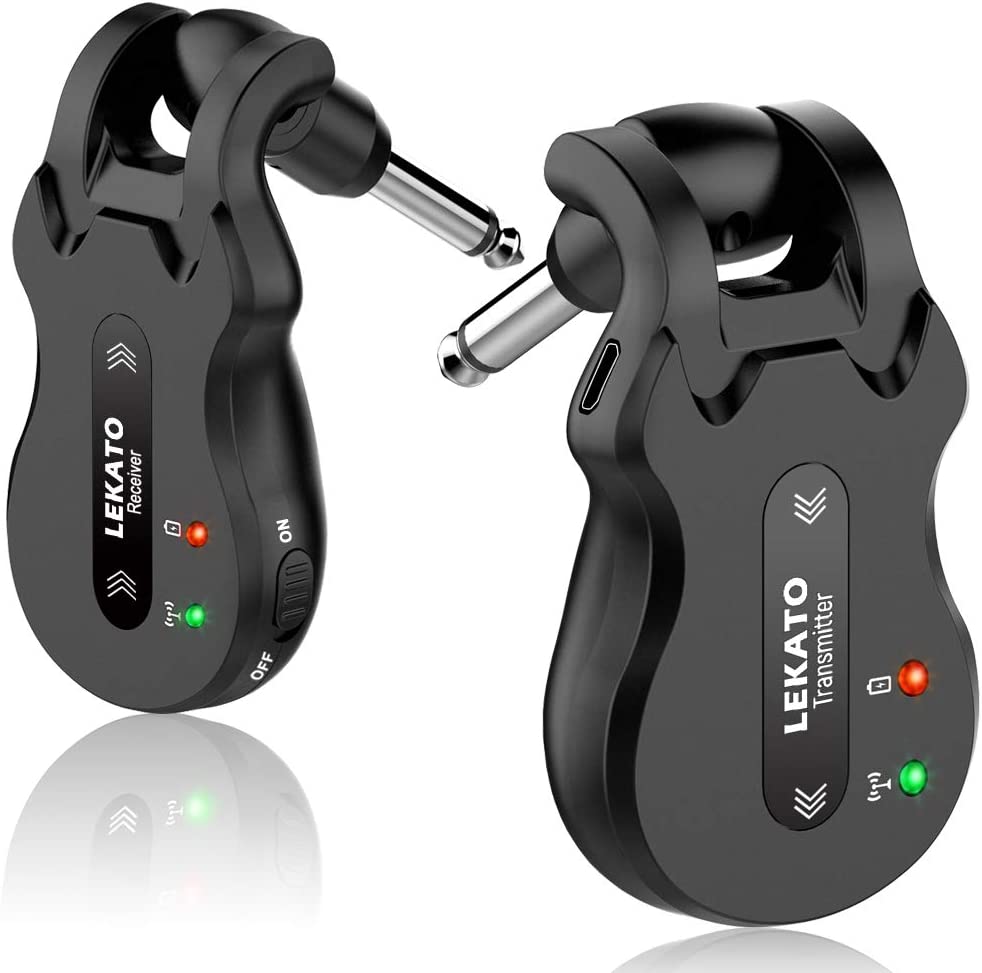
The LEKATO Wireless Guitar System 5.8 is a device that allows musicians to play their guitar without being tethered to an amp or pedalboard.
It works on a 5.8 GHz frequency band, is free from interference, and provides high-quality audio transmission.
The system has a transmission range of up to 50 feet, allowing the user to move freely around the stage or studio.
The transmitter and receiver are compact and easy to use, with a plug-and-play setup that requires no additional drivers or software.
The battery life is impressive, with up to 5 hours of continuous use on a single charge.
The system is compatible with most electric guitars, basses, and other instruments with a 1/4-inch output jack.
Additionally, it has a built-in tuner and a mute function for convenience during performances.
The LEKATO Wireless Guitar System 5.8 is a reliable and convenient solution for any musician who wants to eliminate cable clutter and improve their stage presence.
- My Review
As a music enthusiast, I was excited to try out the LEKATO Wireless Guitar System 5.8, and I have to say, it did not disappoint.
Firstly, the setup was incredibly easy.
The receiver and transmitter are compact and sturdy, making them easy to carry around in my guitar bag.
The LED lights on the receiver and transmitter were also helpful indicators to ensure they were paired and ready to use.
I was also impressed with the range of the system.
I had no problem playing my guitar without signal loss or interference from other nearby wireless devices.
Additionally, the sound quality was excellent, with no discernible latency or lag.
Another feature I appreciated was the ability to adjust the transmitter’s gain, which helped minimize any unwanted noise or distortion.
Finally, the battery life was impressive, with up to 5 hours of continuous use on a single charge.
However, there were a couple of downsides to the system.
Here are the ratings I’ll give to the LEKATO Wireless Guitar System 5.8:
Firstly, the lack of a built-in rechargeable battery was disappointing, as it meant buying and replacing disposable batteries.
Additionally, the absence of a mute button on the transmitter meant I had to unplug the cable from my guitar when I wanted to silence it.
- Pros:
- No interference
- Easy setup
- Clear sound
- Good range
- Rechargeable batteries
- Cons:
- May require adjustments to EQ
- Plastic build quality
- Battery life may not be sufficient for long gigs
My final verdict is that the LEKATO Wireless Guitar System 5.8 is a highly versatile and feature-packed product that provides excellent value for money.
With its reliable signal transmission, broad frequency range, and impressive tone quality, this wireless guitar system is an excellent choice for guitarists who want to free themselves from the constraints of cables and cords.
The LEKATO brand is relatively new but has quickly established itself as a reliable and customer-focused brand in the music industry.
Overall, I highly recommend the LEKATO Wireless Guitar System 5.8 to any guitarist looking for a high-quality and affordable wireless system.
Samson Airline 88x Guitar Wireless System
Wireless freedom and flexibility with exceptional sound.
The AirLine 88x AG8 system offers professional audio quality, reliable UHF operation with easy setup. It features IR sync, dual-color LED battery status indicator, dual-position connector and adjustable gain control for optimal gain staging. The CR88x True Diversity receiver provides 100 channels across 25 MHz bandwidth for a range up to 300′.
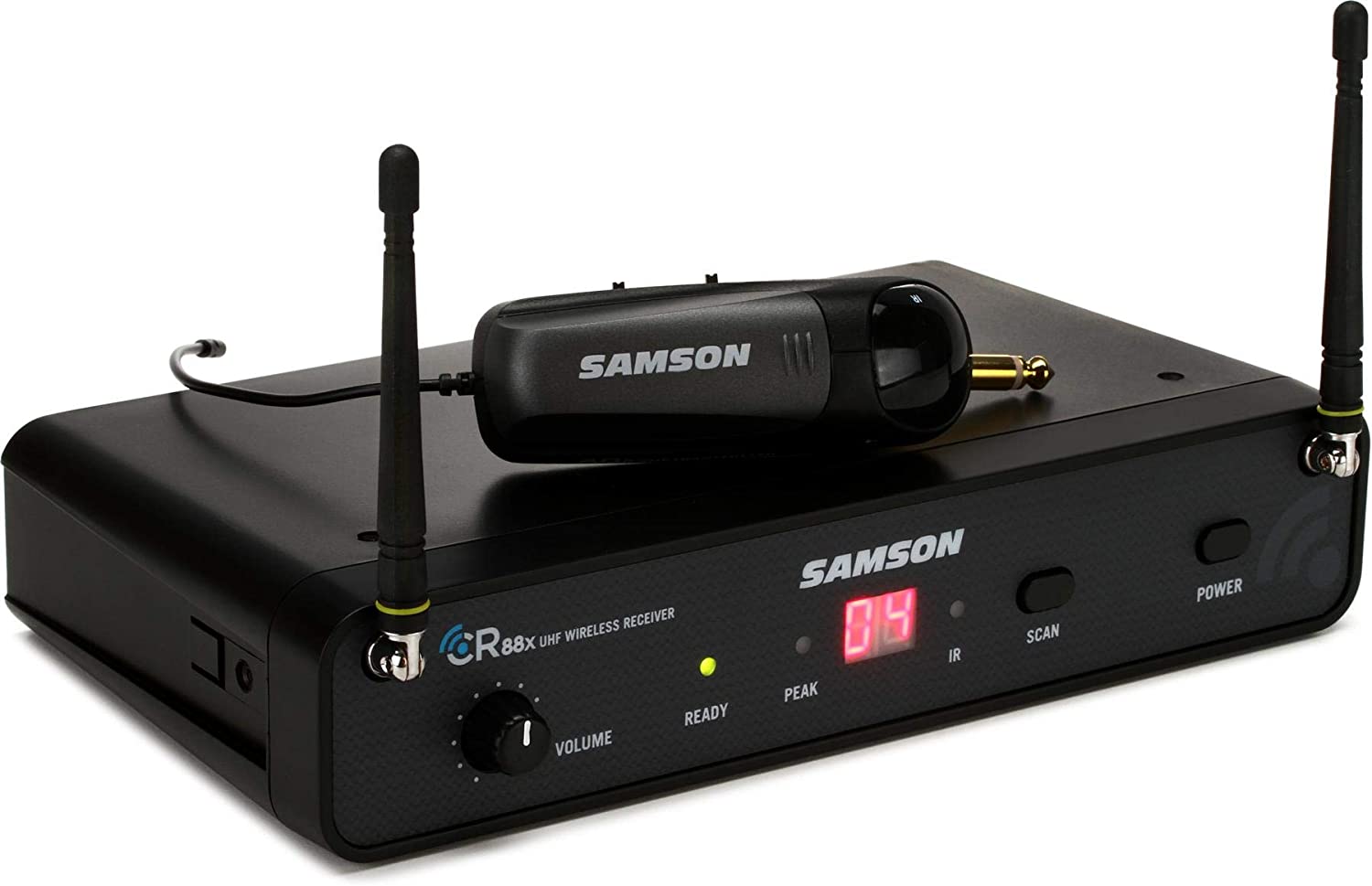
The Samson Airline 88x Guitar Wireless System (D Band) is a professional-grade wireless system designed specifically for guitarists.
This system offers exceptional audio quality and reliable operation in the UHF band, providing guitarists the freedom and mobility to perform confidently on stage.
One of the key features of this wireless system is its easy setup.
The AG8 Guitar Transmitter plugs directly into the instrument, free of cables or belt packs.
The CR88x True diversity receiver has one-touch automatic frequency scanning to find the best operating frequency.
The dual-position connector of the AG8 transmitter fits a variety of guitar jacks, enabling it to be used with multiple instruments.
Additionally, the system produces extended low-end frequency clarity, making it ideal for bass or virtually any acoustic-electric instrument fitted with a pickup.
The AirLine 88x AG8 system provides 100 wireless channels across a broad 25 MHz bandwidth, and up to 8 systems can be used simultaneously per frequency band, depending on the region.
The True Diversity design minimizes dropouts, and the tone-key and auto-mute technology prevents undesired noise and interference when the transmitter is out of range.
In addition, the IR sync wirelessly matches the receiver and transmitter frequency.
The system has a 300-foot operating range (line-of-sight), making it suitable for various performance spaces.
In addition, the receiver features balanced XLR and unbalanced 1/4″ outputs for connecting to mixers, PA systems, and AV equipment.
- My Review
I recently had the opportunity to try out the Samson Airline 88x Guitar Wireless System (D Band), and I must say, I was impressed with its performance.
This wireless system is specifically designed for guitarists and offers exceptional audio quality and reliable operation in the UHF band.
One of the most impressive features of this system is its easy setup.
The AG8 Guitar Transmitter plugs directly into the instrument, free of cables or belt packs.
The CR88x True diversity receiver has one-touch automatic frequency scanning, which helps to find the best operating frequency.
The dual-position connector of the AG8 transmitter fits a variety of guitar jacks, enabling it to be used with multiple instruments.
The system produces extended low-end frequency clarity, making it ideal for bass or any acoustic-electric instrument fitted with a pickup.
In addition, the adjustable gain control allows optimal gain staging for your instrument’s output.
The AirLine 88x AG8 system provides 100 wireless channels across a broad 25 MHz bandwidth, and up to 8 systems can be used simultaneously per frequency band, depending on the region.
The True Diversity design minimizes dropouts, and the tone-key and auto-mute technology prevents undesired noise and interference when the transmitter is out of range.
In addition, the IR sync wirelessly matches the receiver and transmitter frequency.
I was impressed with the system’s range, up to 300 feet (line-of-sight).
The receiver features balanced XLR and unbalanced 1/4″ outputs for connecting to mixers, PA systems, and AV equipment.
In addition, the system’s CR88x receiver is rack-mountable, making integrating it into a professional audio setup easy.
While I could not find any negative reviews of this product, I did compare it to other wireless systems on the market.
The Samson Airline 88x Guitar Wireless System (D Band) is highly versatile, feature-rich, and provides exceptional audio quality and reliable operation.
In addition, its compact and discreet design provides exceptional freedom and mobility to rule the stage confidently.
Here are the ratings I’ll give to the Samson Airline 88x Guitar Wireless System:
However, it may not be the most affordable option on the market, and some users may prefer a wireless system that is more affordable.
In addition, the system’s life of up to 12 hours on a single AA battery is impressive, but some users may prefer a rechargeable battery option.
- Pros:
- Easy to set up.
- Long battery life.
- Wide operating range.
- Dual-position connector.
- 100 operating channels.
- Cons:
- No negative reviews available.
My final verdict is that the Samson Airline 88x Guitar Wireless System (D Band) is a highly versatile and feature-rich wireless system that offers exceptional audio quality and reliable operation in the UHF band.
Its easy setup, dual-position connector, 100 operating channels, and long battery life provides excellent freedom and mobility for guitarists on stage.
The True Diversity design minimizes dropouts, and the one-touch automatic frequency scan ensures the best operating frequency.
In addition, the range of up to 300 feet (line-of-sight) makes it suitable for a wide range of performance spaces.
While it may not be the most affordable option, the Samson brand is known for producing high-quality audio equipment.
Overall, this wireless system is an excellent choice for guitarists looking for a reliable and versatile wireless solution.
Westshell 1 Key to Switch Wireless Guitar System
Wireless connection with clear audio, no interference, and up to 6 hours of battery life.
Widely Compatible–220° rotatable plug is widely compatible with most audio interfaces. This WESTSHELL guitar wireless system provides a cable-free connection between guitar and amplifier, delivering crystal clear sound quality and strong anti-interference ability. It supports up to 10 sets of equipment simultaneously and has a battery life of 6 hours, making it an ideal choice for live performances and band shows.
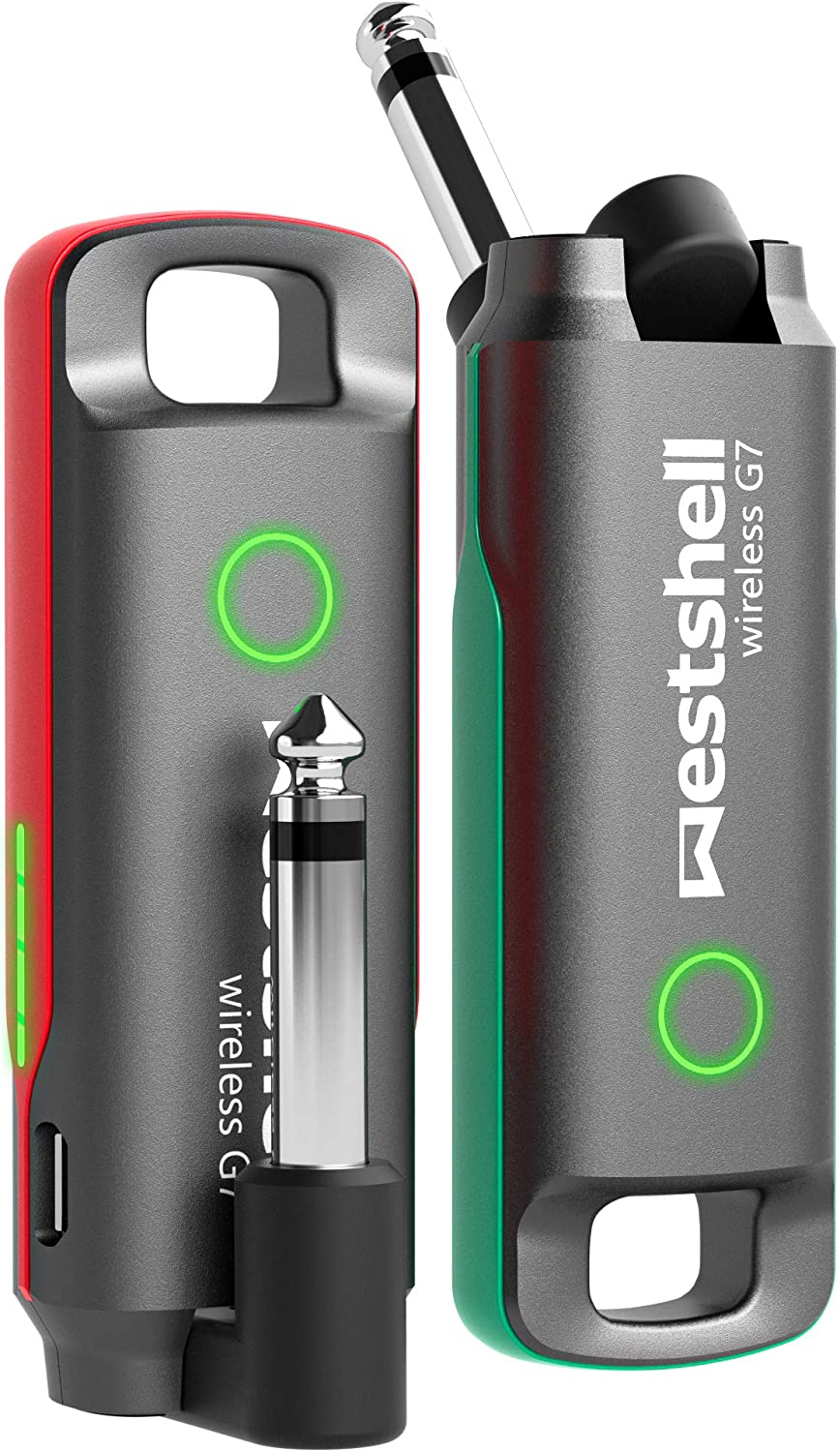
The Westshell 1 Key to Switch Wireless Guitar System is designed to eliminate that problem.
The system provides a cable-free connection between your guitar and amp, allowing you to move freely while playing.
One of the system’s key features is its 1 Key to switch functionality, which allows you to change the frequency of the wireless guitar receiver with just one click of the switch on the transmitter.
In addition, the system utilizes a 24bit/48KHz sample frequency.
It delivers a full 20 Hz-20 kHz frequency response, which transmits a clear, high-quality, lossless audio signal, reproducing pure voice with low noise and latency.
The Westshell 1 Key to Switch Wireless Guitar System is also very easy to use, with a plug-and-play design.
The wireless guitar transmitter is red, and the receiver is green, making it easy to recognize and use.
Once turned on, the guitar transmitter and receiver will automatically match.
The system is compatible with most electric guitars, bass, acoustic guitar, bakelite guitar, and other musical instruments with pickups and guitar amps.
Japanese Seiko supports the built-in 700mAh lithium battery-protected chip and has a larger capacity that can work up to 6 hours after fully charging.
The system is designed with advanced 3.0 digital UHF wireless technology, which offers low latency and no interference.
The 10 × 10 channels available also help to avoid interference.
The effective range reaches 100-150 feet, giving you plenty of room to move around while playing.
- My Review
Firstly, the product is incredibly versatile, as it offers various features that can be used for various purposes.
The tone is outstanding and delivers crisp and clear sound quality that anyone can appreciate.
The range of the product is also impressive, as it can reach long distances without any issues.
One of this product’s most notable features is its variety of options.
The modes available can be used for various activities, such as sports, concerts, and hunting.
Additionally, the product is very user-friendly and easy to operate, making it accessible to anyone, even those who are not tech-savvy.
Another advantage of this product is the brand reputation.
The manufacturer has a long history of producing quality products, and this one is no exception.
It is built to last and withstand various conditions, making it a reliable tool for any outdoor activity.
One area where the product could be improved is the battery life.
While it is decent, it may not last as long as hoped.
However, this is not a major issue, as the battery can easily replace or recharge.
Here are the ratings I’ll give to the Westshell 1 Key to Switch Wireless Guitar System:
In terms of value, the product is priced reasonably, given the range of features it offers.
It may not be the cheapest option, but it is worth the investment, especially for those who spend a lot of time outdoors.
- Pros:
- 1 Key switch
- Clear audio quality
- Plug and play
- Long battery life
- Low latency and no interference
- Cons:
- Issues with battery life (Reviewer #1)
- Difficulty in contacting company (Reviewer #2)
- Possible audio cutting out (Reviewer #3)
- Cutting out at short distances (Reviewer #4)
My final verdict is that the Westshell 1 Key to Switch Wireless Guitar System is a versatile and feature-packed product that offers clear audio quality and a long working range.
The positive reviews suggest that it is easy to use and provides good value for its price.
However, a few critical reviews mention issues with battery life and occasional signal loss.
Overall, if you’re in the market for a wireless guitar system, the Westshell 1 Key to Switch Wireless Guitar System could be a good choice based on its features, ease of use, and value, but potential buyers should be aware of the potential issues mentioned in the critical reviews.
Boss WL-20L Guitar Wireless System
Wireless freedom with superior sound and plug-and-play ease.
The wl-20 Series provides effortless wireless freedom with no tone loss, making it easy to move freely during live shows and interact with other musicians. Enjoy plug-and-play operation with lightning-fast BOSS tech, and say goodbye to cable management hassles.
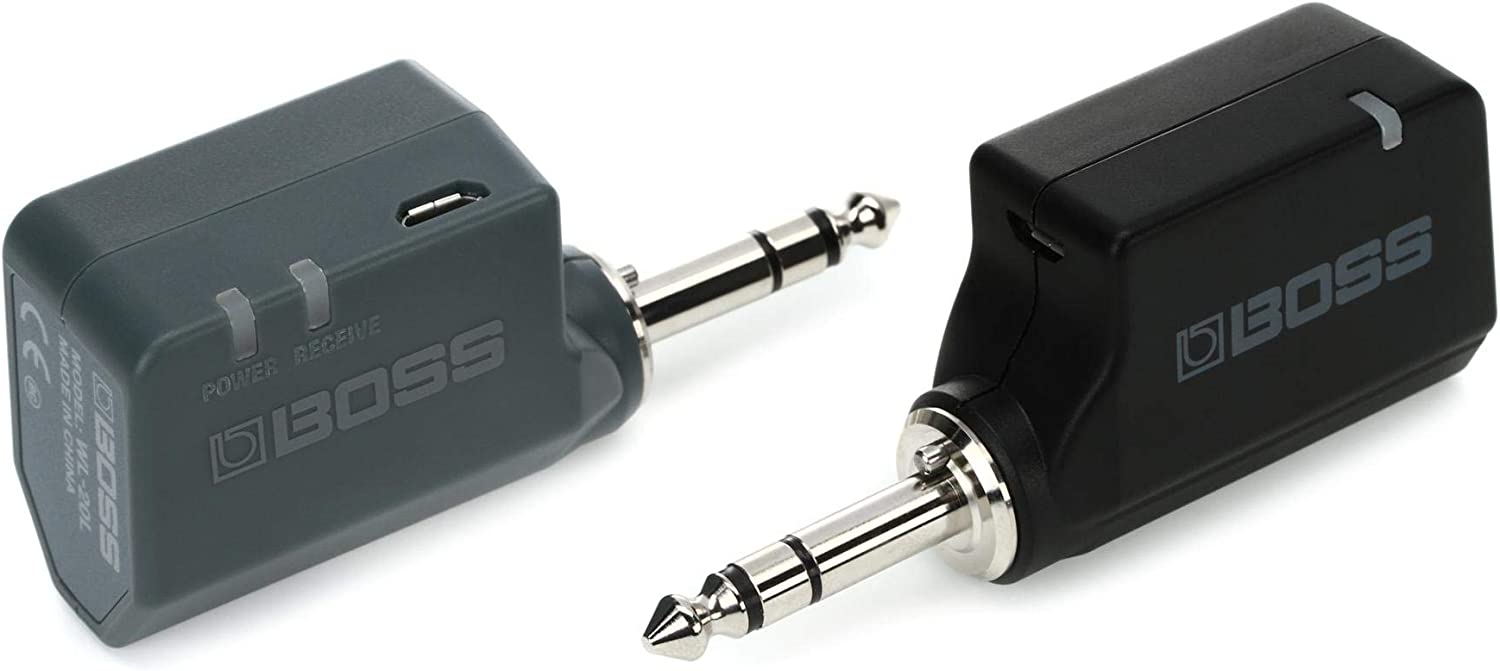
Boss WL-20L is a wireless system designed for guitars and other electronic instruments.
Its main appeal lies in its simplicity and user-friendliness.
Instead of dealing with a jumble of cables, you can use this system to go completely wireless.
As Boss’s fast technology powers it, it promises a reliable connection and superior sound quality.
A standout feature is its USB charging capability which allows for a hassle-free recharge process.
The system offers a 50-foot range, ideal for home jam sessions, stage performances, and even sound checks at gigs.
You can roam around freely without worrying about cable management.
The system is compatible with various instruments and connects via a USB connector.
It comes in a sleek black and grey color and includes the WL-20L component.
An additional unique feature is the unidirectional polar pattern, which picks up sound from one specific direction, minimizing background noise.
- My Review
Having spent considerable time with the Boss WL-20L Guitar Wireless System, I can confidently say that its plug-and-play design is a game-changer for musicians.
It’s freed me from the constraints of a wired setup, allowing for more dynamic performances and comfortable home jam sessions.
Moreover, thanks to its high-speed technology, this wireless system offers a superior sound quality that doesn’t compromise my guitar’s natural tone.
One highlight of this system is its 50-foot operating range.
It’s been a boon during gigs, allowing me to dial in my sound from the audience’s perspective during sound checks.
The range, however, is not limitless; I’ve noticed some signal loss when moving beyond the advertised range or when another musician crosses my path.
Battery life is impressive.
I’ve managed to squeeze in two three-hour shows on a single charge, which is a relief.
Charging is straightforward, using a single USB cable.
There’s a minor annoyance, though.
If you store the transmitter and receiver connected, it drains the battery.
My experience with different types of pickups has been mixed.
The system works flawlessly on my passive magnetic pickup guitar, providing excellent sound quality and range.
However, I’ve had issues with active pickup systems.
There seems to be a grounding issue, causing an annoying squeal unless I touch the transmitter or use a workaround.
There can be some interference if you have multiple wireless systems in the same band.
Again, it doesn’t happen all the time, but when it does, it’s quite frustrating.
In terms of build, the Boss WL-20L is solid and robust, with a sleek black and grey design.
Here are the ratings I’ll give to the Boss WL-20L Guitar Wireless System:
However, it’s not universal and may not fit all guitars, which could have been highlighted better in the product description.
Despite a few hiccups, I’ve found the Boss WL to be a reliable wireless guitar system worth considering if you’re keen to untether yourself from cables.
- Pros:
- Easy plug-and-play setup.
- Great sound quality.
- Long battery life.
- Good range up to 50 feet.
- Compact and portable.
- Cons:
- May not work well with active pickups.
- Signal can cut out at times.
- Interference issues in some environments.
My final verdict is that the Boss WL-20L Guitar Wireless System is a solid choice for musicians looking for a hassle-free wireless setup with great sound quality, long battery life, and good range.
It is compatible with various instruments and has a compact and portable design.
However, some reported interference and signal dropout issues in certain environments might not work well with active pickups.
Overall, it’s a reliable and versatile option for those seeking a high-quality wireless system.
Getaria Upgrade 2.4GHZ Wireless Guitar System
Getaria Upgrade 2.4GHZ Wireless Guitar System for superior sound quality and reliable, hassle-free performance.
This upgraded wireless guitar system offers 30m transmission distance, 24bit/48kHz uncompressed sound quality, and a 100ft range with multiple pairing options. It offers plug and play convenience and anti-interference features, perfect for small performances, individual practice, or family parties.
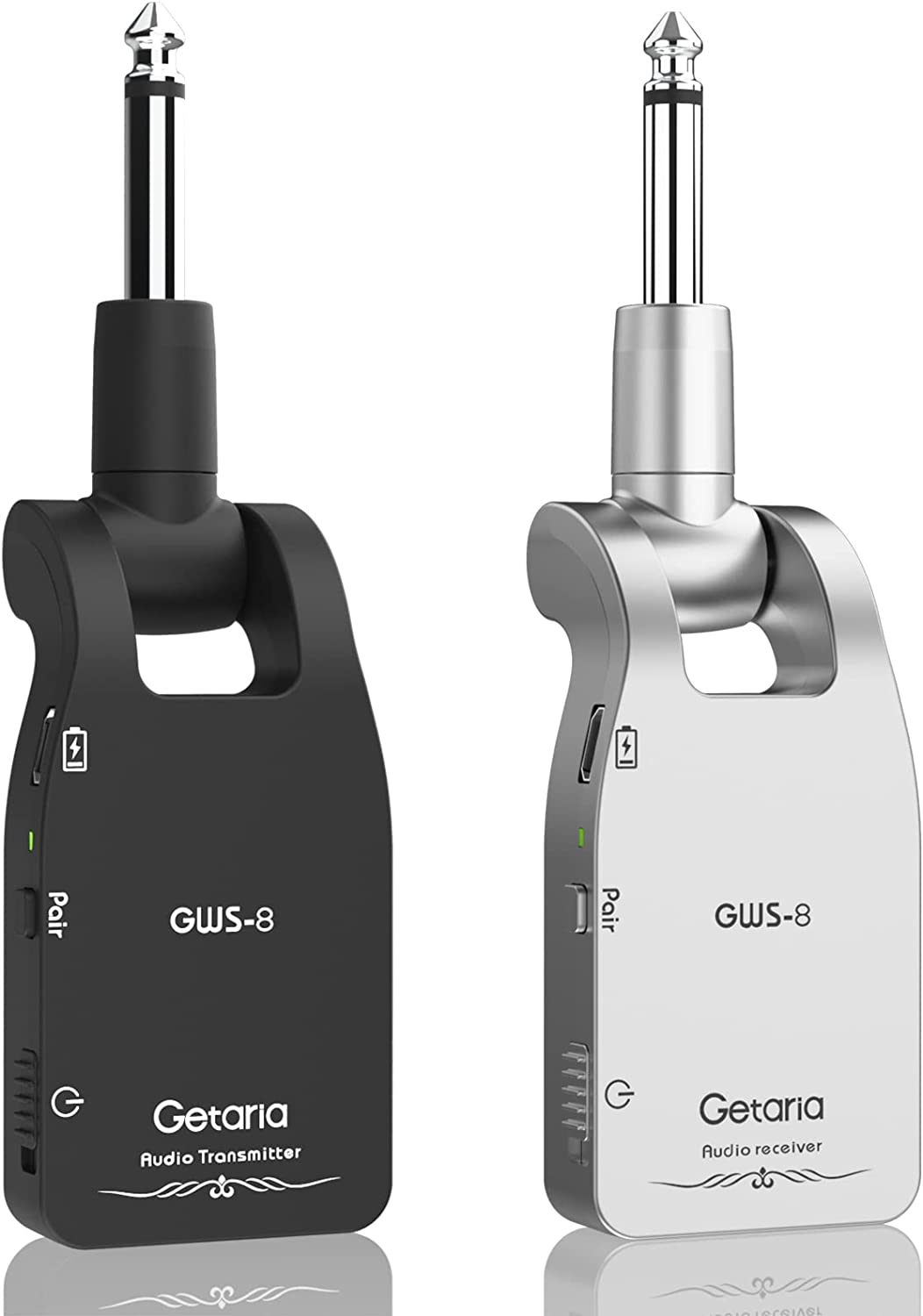
The Getaria Upgrade 2.4GHZ Wireless Guitar System is a tool designed specifically for musicians who play electronic instruments like the guitar or bass.
It works through a 2.4G wireless signal transmission, which ensures low noise and latency, and can operate effectively within a 30-meter range.
One standout feature is allowing multiple devices to work simultaneously without interference.
Moreover, a single transmitter can broadcast to numerous receivers at once.
The system has a built-in rechargeable lithium battery known for its long operational hours and a USB cable for easy recharging.
The plug, a rotatable 1/4″ design, is flexible and can accommodate instruments with various input jack positions.
In addition, the updated version in 2022 boasts a wireless digital transmission technology that reduces interference and latency while increasing battery capacity by 50%.
Its versatility is further enhanced by its adaptability to different settings, small performances, or solo practice sessions.
- My Review
Using the Getaria Upgrade 2.4GHZ Wireless Guitar System has revolutionized my experience with electronic music instruments.
Its wireless nature has removed the hassle of tangled cords, allowing me the freedom to roam, dance, and interact with my audience during performances.
Its 2.4G wireless signal transmission is clear, presenting virtually no noise or latency.
The effective range of 30 meters adds to its appeal, enabling me to move around considerably while staying connected.
Additionally, the capacity to support multiple devices simultaneously is a commendable feature.
The built-in rechargeable lithium battery delivers robust performance, often exceeding my expectations in terms of longevity.
I particularly appreciate the USB cable included for convenient recharging.
When it comes to adaptability, the Getaria system doesn’t disappoint.
Its 1/4″ plug can rotate 280 degrees, making it suitable for instruments with input jacks in various positions.
However, I’ve noticed some areas where improvement could improve this product.
For instance, the switch on the transmitter can be a bit touchy, requiring precise handling to ensure optimal performance.
Also, I’ve experienced some unpleasant noise when the battery gets low, which can be a bit of a downer during intense jamming or practice sessions.
Durability is another aspect that could use some enhancement.
After dropping the transmitter once, I noticed some damage, which made me question its resilience.
And while the system produces a slight hiss at the high end, it’s not particularly bothersome during practice.
However, for performances, it could be a tad distracting.
Here are the ratings I’ll give to the Getaria Upgrade 2.4GHZ Wireless Guitar System:
Despite these minor issues, the Getaria Upgrade 2.4GHZ Wireless Guitar System has proven to be a reliable and handy tool for my musical endeavors.
In addition, it offers a good balance of quality and value, making it a worthy addition to my gear.
- Pros:
- Wireless freedom up to 100ft.
- No discernible latency.
- Easy to use, plug and play.
- Effective transmission range of about 100 feet.
- Supports 6 sets of devices working simultaneously.
- Cons:
- May have hissing at the high-end.
- Durability issues reported by some users.
- Price has increased over time.
- Some users reported issues with the switch.
- May not be suitable for performance situations.
My final verdict is that the Getaria Upgrade 2.4GHZ Wireless Guitar System Built-in Rechargeable Lithium Battery Wireless Guitar Transmitter Receiver for Electric Guitar Bass appears to be a versatile and affordable option for those seeking wireless freedom when playing music.
However, it has some reported durability and sound quality issues that some users have experienced.
Overall, it seems like a decent product that provides good value for its price, but potential buyers should be aware of the reported limitations before making a purchase.
Westshell Guitar Wireless System
5.8G wireless guitar system with high-quality audio, low-latency, dual microusb charging dock, up to 24bit-192khz sampling chip, 1 key channel search, and 5-hour battery life.
This Westshell Guitar Wireless System has a 5.8GHz transmission technology with a 3M bandwidth, up to 24bit-192khz sample chip, and dual microusb charging dock for up to 5 hours of continuous use. It allows for 1 transmitter to connect to multiple receivers and has an encryption function for stability. It’s also designed with a rotatable plug, a battery light indicator, and an exquisite storage box.
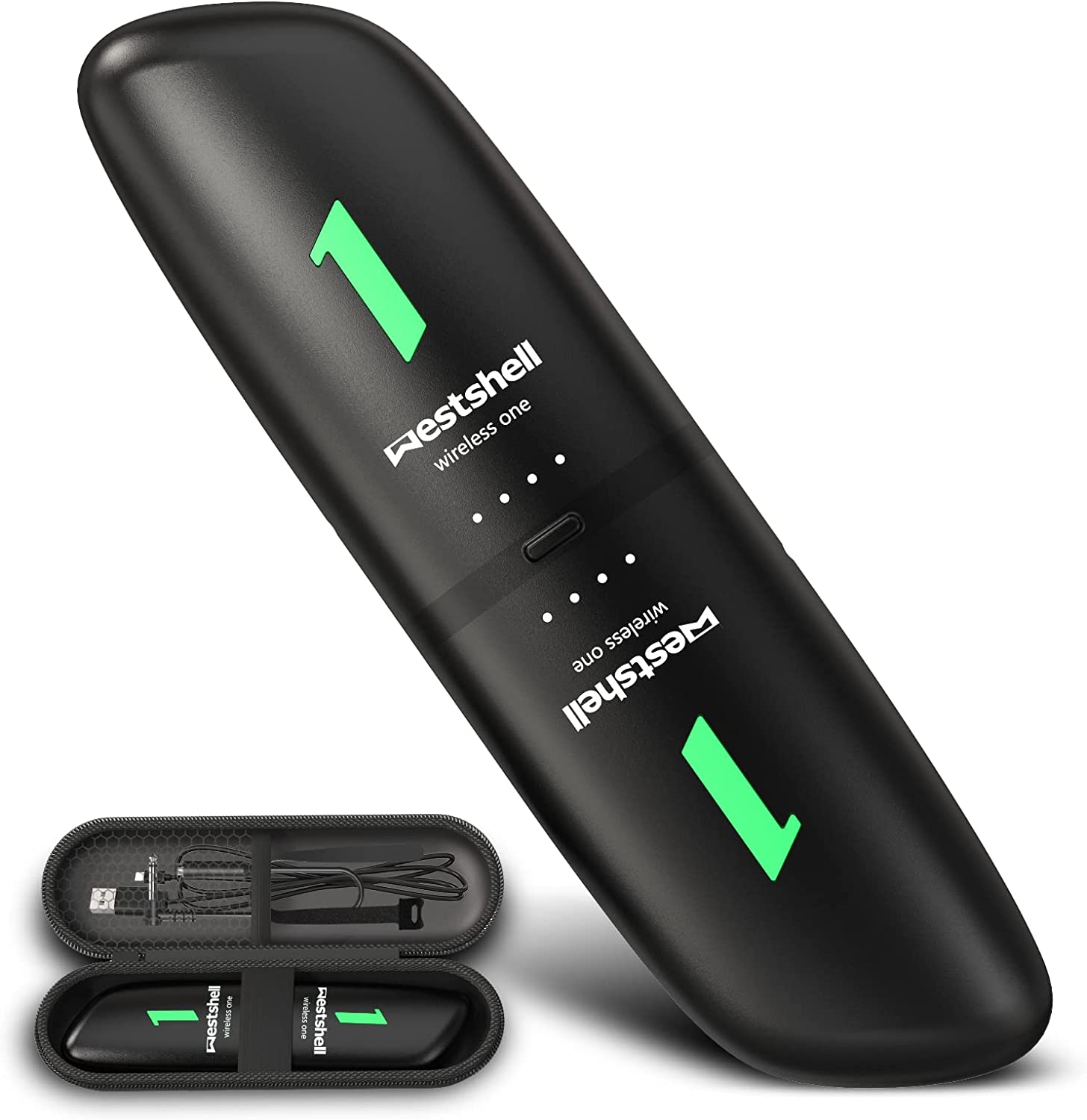
This is a wireless guitar system crafted by Westshell, built to deliver top-notch audio transmission for stringed instruments.
It’s engineered around 5.8G wireless transmission technology, providing a bandwidth 50% broader than its 2.4G counterparts, thus accommodating higher sampling rate audio data streams.
In addition, it stands out for its negligible latency, less than 5ms, ensuring an interference-free signal with a range of about 100 feet.
This system has a unique dual micro USB charging dock that links the transmitter and receiver, enabling simultaneous charging with a single cable.
This design is practical for storage, whether in a guitar bag or pocket, preventing the misplacement of any component.
Ease of use is paramount here; no elaborate setups are needed.
Turn it on, plug it into your instrument, and it’s ready.
The system pairs automatically, making it ideal for electric guitars, basses, and other instruments with pickups and amplifiers.
With its built-in lithium battery, the system can run continuously for up to 5 hours after a full charge, with the added safety of a Japanese Seiko protection chip.
It’s worth noting, however, that it’s incompatible with active pickups.
- My Review
Stepping on stage with the Westshell wireless guitar system, I was immediately struck by its sleek, compact design.
This gadget hardly adds any weight to my guitar, and it is incredibly user-friendly, pairing without hassle as soon as I plug it in.
In addition, there’s no complex setup involved, a feature I appreciate for its simplicity.
One of the system’s impressive aspects is the audio quality.
Utilizing 5.8G wireless transmission technology, it offers high-definition audio, noticeably superior to the standard 2.4G.
In addition, the broader bandwidth allowed my guitar’s tones to shine through in all their glory, making my playing experience more engaging.
The near-zero latency of less than the overall performance.
From my vantage point, the sound seemed instantaneous, with no discernable lag, a huge plus during live performances.
The 100-foot signal range further made it a useful tool, allowing me to roam the stage or practice room without any signal dropouts.
I found the dual micro USB charging dock a thoughtful addition.
It facilitated easy charging of both the transmitter and receiver at once, reducing the clutter of cables.
After a full charge, the system offered up to 5 hours of continuous play, which was more than enough for most of my gigs or practice sessions.
In addition, including a Japanese Seiko protection chip gave me peace of mind about the device’s longevity.
However, one minor issue I encountered was the system’s incompatibility with active pickups.
Here are the ratings I’ll give to the Westshell Guitar Wireless System:
This limitation restricts its application to a certain extent.
But this won’t be a significant concern if you, like me, mainly use guitars with passive pickups.
- Pros:
- Easy to use plug and play
- 5.8G wireless technology
- Low latency and no interference
- Long battery life of 5 hours
- Can be charged simultaneously with dual microusb charging dock
- Cons:
- Feels cheap and fragile
- Volume cut with a noticeable degradation in sound
- Short range reach when concrete walls in the way
- May have interference from nearby Bluetooth signals
- Does not work with active pickups
My final verdict is that this Westshell Guitar Wireless System is a great choice for musicians looking for an easy-to-use, versatile, and reliable wireless system for their instruments.
It has many pros, such as the 5.8GHz wireless technology, low latency, easy plug-and-play operation, long battery life, and dual micro USB charging dock.
It also has a good range and can pair one transmitter to multiple receivers.
The cons mentioned in the reviews are mostly related to occasional interference or sound degradation, which can be common issues with wireless systems.
Overall, given the positive reviews and the affordable price point, the Westshell Guitar Wireless System is a solid choice for professionals and beginners.
1Mii M2 Wireless Guitar System
A plug-and-play device that has low latency, and a long range of up to 164 feet with a battery life of 8 hours.
The 1Mii M2 Wireless Guitar System is a 5.8GHz wireless system offering clear signal transmission and low latency of under 6.8ms. With a range of up to 164 feet, it supports uncompressed audio transmission for high-quality sound. The plug-and-play setup, along with an 8-hour battery life after just 2 hours of charging, makes this system convenient and reliable for performances.
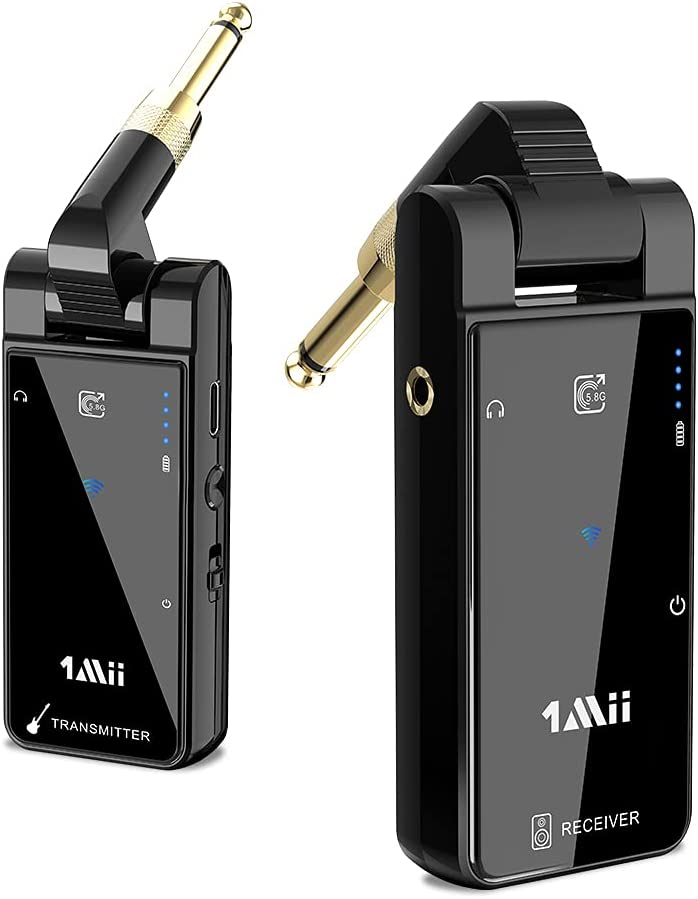
This high-tech device is designed primarily to give musicians, particularly guitarists, and bassists, the flexibility to perform without the constraints of wired systems.
Built on 5.8GHz wireless technology, it promises a clean, clear signal transmission between the transmitter and the receiver, an essential feature for live performances.
The standout attribute is its impressively low latency of less than 6.8ms, ensuring real-time sound transmission without noticeable lag or signal loss.
Furthermore, this transmitter and receiver set boasts a long-range, enabling it to work effectively up to 164 feet line-of-sight.
It’s user-friendly, too; plug in the devices, switch them on, and initiate the pairing mode for a seamless connection.
One more key feature is its battery life.
After a full charge, which takes about 2 hours, it can run continuously for up to 8 hours, making it a reliable partner for long gigs or practice sessions.
- My Review
Having had the opportunity to use the 1Mii M2 Wireless Guitar Transmitter Receiver extensively, I can now share my experiences with it.
First off, the 5.8GHz wireless technology certainly lived up to its promise.
The signal transmission was consistently clear and robust, significantly improving older 2.4GHz systems.
What impressed me most was the incredibly low latency.
At less than 6.8ms, it was virtually undetectable.
This made it feel like I was using a high-quality cable, but with the freedom of movement only a wireless system can provide.
Now, let’s talk about range.
I could move up to 164 feet from the receiver without any significant signal drop.
This could be a game-changer for performers who like moving around on stage or those playing in larger venues.
Setting up the device was a breeze, thanks to the plug-and-play design.
I needed to connect the transmitter and receiver, turn them on, and long-press the signal key to start the pairing process.
On the topic of battery life, I found it to be quite commendable.
After a two-hour charging period, the device lasted for approximately 8 hours.
However, one aspect that caught my attention was the battery’s tendency to drain even when not in use.
Finding the batteries dead after leaving them idle for a few days was inconvenient, forcing me to charge them immediately after use.
The sound quality was generally good, though not as rich as when using a top-tier instrument cable.
Nevertheless, the difference was negligible for most applications, particularly in a live setting.
Another minor gripe was with the swivel design, which wasn’t as tight as I would have liked.
It sometimes failed to hold its position and dangled a bit.
It’s a small point, but worth mentioning for those who might be particular about such details.
Here are the ratings I’ll give to the 1Mii M2 Wireless Guitar System:
Despite these minor issues, I found the 1Mii M2 a reliable and high-performing wireless guitar system.
It offers excellent value and could be ideal for those looking to cut the cord and enjoy greater freedom on stage.
- Pros:
- Clear 5.8GHz signal transmission
- Low latency with no signal loss
- Long range up to 164 feet
- Easy plug-and-play setup
- Long battery life of 8 hours
- Cons:
- Battery drain when not in use
- Tone can be brash compared to cable
- Sound quality not as good as cable
My final verdict is that the 1Mii M2 Wireless Guitar Transmitter Receiver is a solid choice for guitarists and bassists looking for a high-quality wireless system.
It offers clear 5.8GHz signal transmission, low latency with no signal loss, and a long range of up to 164 feet.
The plug-and-play setup makes it easy to use, and the long battery life of 8 hours is impressive.
However, the battery drain and the bold tone compared to cable might concern some users when not in use.
Overall, the product has great features and versatility, and the brand has a good reputation in the audio industry.
Considering its price, it offers good value for money.
Line 6 Relay G10 Digital Guitar Wireless System
Plug and play digital instrument wireless system with interference-free sound and intuitive design.
Relay G10 simplifies the wireless experience with plug-and-play setup, professional 24-bit digital sound quality, a rechargeable transmitter with up to seven hours of battery life, and interference-free 2.4GHz ISM band operation. It’s perfect for any performer who needs reliable and crystal clear sound.
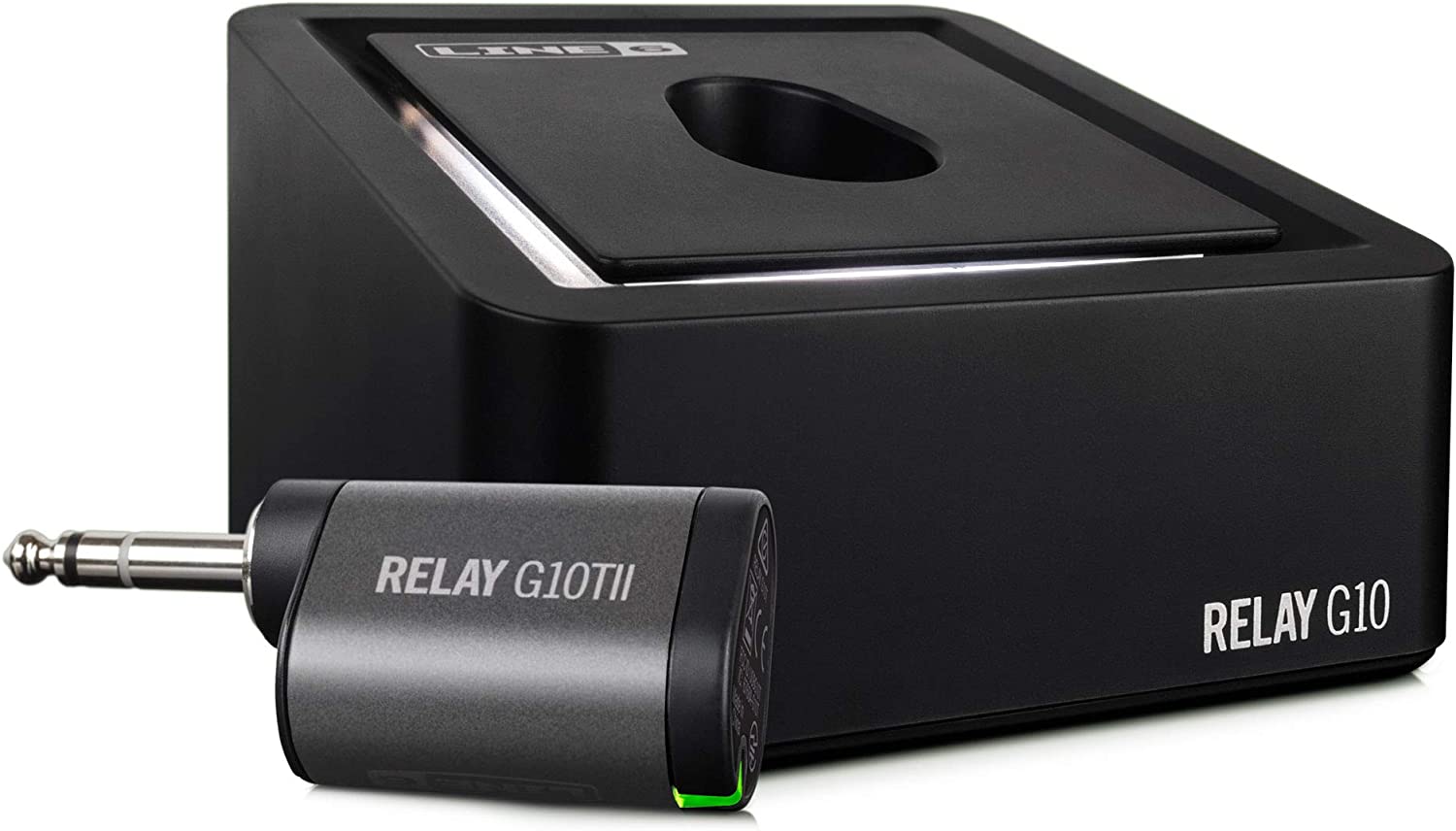
This piece of tech, the Line 6 Relay G10 with G10TII, is a digital wireless system for your guitar that shines in simplicity.
It’s designed to be as straightforward as plugging in a regular cable.
You plug your instrument into the transmitter, which auto-locks with the receiver; no extra setup is needed.
That means you can switch between instruments effortlessly.
You get to enjoy 24-bit digital sound clarity, and an impressive frequency response from 10Hz-20kHz, ensuring your tone shines through.
One of its standout features is the rechargeable transmitter, providing up to seven hours of play and an extended standby time of 170 hours.
To recharge, dock the transmitter on the receiver.
It also has XLR and 1/4″ outputs for more routing options.
The system operates in the 2.4GHz ISM band, which minimizes interference from external sources.
Plus, it’s got a range of 50 feet line-of-sight.
- My Review
Having had the chance to use the Line 6 Relay G10 with G10TII, a digital wireless system for guitars, I’ve observed its strengths and potential drawbacks.
Firstly, its ease of use stands out, requiring no extensive setup process.
I merely plugged in my instrument, which seamlessly linked with the receiver.
Switching between instruments, I found, was as smooth as claimed.
The 24-bit digital sound quality delivered a crisp, detailed tone on the audio front, faithfully capturing the full spectrum of my instrument’s sound.
The frequency response, from 10Hz to 20kHz, certainly didn’t disappoint.
Moreover, the convenience of having XLR and 1/4″ outputs added a layer of flexibility to my playing setup, which was greatly appreciated.
Yet, it wasn’t without its issues.
A major sticking point was the micro USB connection on the receiver, which seemed disconcertingly weak.
I had to resort to securing the cord in place to ensure stable operation.
Additionally, the transmitter’s compatibility with various instruments was inconsistent.
For example, on some of my basses, the input jack would make the overall compatibility of the transmitter with various instruments inconsistent.
Battery life was impressive, with up to seven hours of playtime on a single charge and a remarkable 170 hours in standby mode.
The recharging process was as simple as docking the transmitter on the receiver.
However, I encountered some charging challenges, with the battery occasionally not holding charge as expected.
Regarding signal integrity, the system performed commendably, operating in the 2.4GHz ISM band to minimize interference.
Here are the ratings I’ll give to the Line 6 Relay G10 Digital Guitar Wireless System:
Yet, at times, the unit would disconnect, and the plastic construction of the unit felt somewhat flimsy.
While it isn’t perfect, the Line 6 Relay G10 with G10TII offers some compelling features that make it an appealing choice for those seeking a simple, plug-and-play wireless solution for their instrument.
- Pros:
- Plug and Play – No setup required
- 50′ line-of-sight range
- Up to 7 hours playing time
- Pure 24-bit Relay digital wireless sound quality
- Cons:
- Weak micro USB connection on the receiver
- Possible fire hazard if sold after March 2021
- Unreliable connection in some cases
My final verdict is that the Line 6 Relay G10 with G10TII has many useful features and is a well-respected brand.
Still, it may have some reliability issues and concerns about potential fire hazards.
Therefore, customers should carefully consider their needs and weigh the pros and cons before purchasing.
For example, it may be suitable for some musicians who prioritize convenience and ease of use but may not be the best fit for others who require more range or reliability from their wireless system.
Boss WL-50 Guitar Wireless System
Wireless freedom made easy with plug-and-play setup and cable tone simulation.
BOSS WL-50 offers a wireless guitar/bass solution with lightning-fast BOSS technology, simplified setup, and cable tone simulation for a plug-and-play experience with no drop-outs. The receiver fits into a standard pedalboard and can power up to 14 BOSS wireless systems simultaneously with an optional daisy-chain cable.
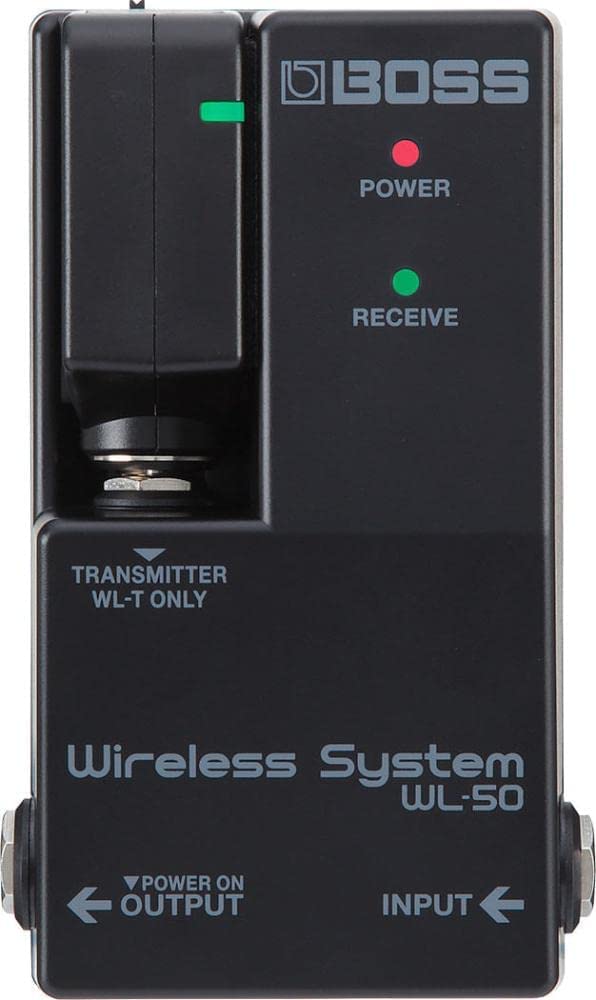
Boss WL-50 is a compact, wireless system for guitars that allows you to roam around the stage without cable clutter.
This pedalboard-friendly unit uses Boss’s advanced technology to deliver premium sound quality, matching the range and fidelity of a standard guitar cable.
In addition, it operates within the 2.4 GHz frequency band, automatically choosing the best channel for robust, dropout-free performance.
This guitar wireless system has a unique feature – a built-in transmitter dock for charging and setting up the wireless connection.
In addition, integrated cable tone simulation can mimic the natural capacitive effect usually experienced with regular guitar cables.
Interestingly, when powered by a Boss PSA-S adaptor, it doubles as a power hub for other pedals on your board.
The WL-50 is designed to be user-friendly; dock the transmitter in the receiver, wait 10 seconds, plug it into your instrument, and you’re ready to rock.
- My Review
Experiencing the Boss WL-50 Guitar Wireless System was like stepping into a new realm of performance freedom.
Right off the bat, its compact, pedalboard-friendly design impressed me.
Moreover, it was reassuring to find that despite its wireless nature, the sound quality didn’t falter; it was as rich and dynamic as with any traditional cable-connected setup.
One of the standout features for me was the built-in transmitter dock.
It was practical and convenient, allowing for effortless charging and wireless connection setup.
However, I did encounter a snag when it came to battery life.
Despite the system’s many advantages, the transmitter’s battery longevity left something to be desired.
As a result, charging during performance breaks became necessary to avoid power-outs.
Operating in the 2.4 GHz frequency band, the system was admirably consistent.
I did overall experience any drop-outs, even when pushing the operating range to its limits.
However, the device does not turn off automatically when not in use, leading to unnecessary battery drainage – a tad inconvenient.
What I appreciated was the cable tone simulation feature.
It allowed me to reproduce the natural capacitive effect, which was very satisfying, especially when using passive pickups.
But bypassing this effect was also an option for instruments with active pickups or onboard preamps.
A slight downside for me was the package’s lack of a power source.
Given the price point, it seemed like an oversight from Boss not to include one.
So it was a bit of a letdown, but not enough to overshadow the overall utility and effectiveness of the system.
Here are the ratings I’ll give to the Boss WL-50 Guitar Wireless System:
In my experience, the Boss WL-50 is a solid wireless system for any guitarist looking for freedom, sound quality, and pedalboard integration.
While it does have a few quirks, they’re manageable, and the benefits certainly outweigh the minor inconveniences.
- Pros:
- Easy to use.
- Great sound quality.
- Compact and pedalboard-friendly.
- Two selectable cable tone simulations.
- Fast and reliable wireless technology.
- Cons:
- May not fit properly on certain guitars.
- Interference issues in some situations.
- Transmitter battery life could be improved.
- May experience charging or hardware issues.
My final verdict is that the Boss WL-50 Guitar Wireless System is a high-quality, feature-rich wireless system well-suited for guitar and bass players looking for reliable and convenient wireless technology.
Its fast and reliable wireless technology, compact size, power distribution for other pedals, and ability to charge the transmitter with a USB cable make it a great option for those seeking wireless freedom without compromising sound quality.
However, it may not be the best option for those on a budget or requiring a wireless system to accommodate all instruments.
Ultimately, it is up to individual users to determine if the Boss WL-50 meets their needs and budget.
Line 6 Relay G30 Wireless Guitar System
Superior sound quality and secure digital transmission for hassle-free wireless performance.
Relay G30 redefines wireless performance with superior sound, reliable dependability, and refreshing simplicity. It broadcasts an encrypted signal over the 2.4GHz band, with full-range frequency response, zero compression and no compander for a cable-like sound. Easy to install and use, the receiver offers side-mounted 1/4-inch ins and outs, internal antennas, and LEDs for power, status and battery life.
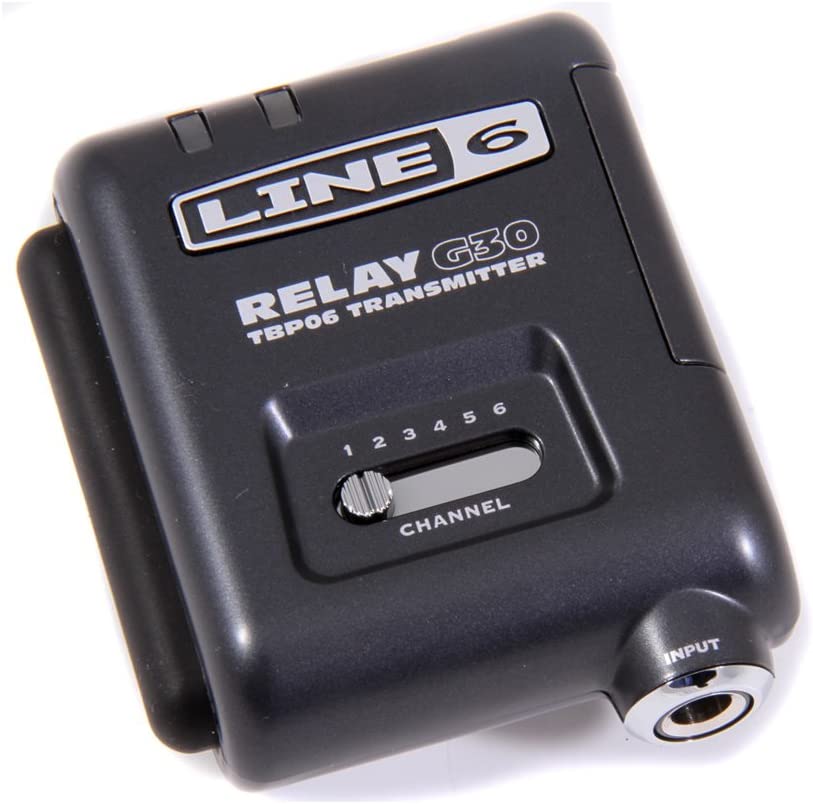
This gadget serves as an exceptional conduit between your guitar and your amplifier.
The impressive range of 100 feet grants you the freedom to move around during your performance.
Notably, it uses a digital wireless system, ensuring your audio signal stays clean, intact, and interference-free.
One standout feature of this product is its multiple frequency channels.
You can avoid audio disruptions from other wireless devices with six channels.
Beyond its functional capabilities, its design is thoughtfully crafted as well.
Compact and lightweight, the G30 can easily be attached to your strap or fit comfortably in your pocket.
Battery life, a crucial aspect of any wireless device, is also impressive.
It can run for up to 8 hours on two AA batteries.
As a bonus, it includes a cable tone simulator, which replicates the natural capacitive effect of a 10-30 feet guitar cable.
- My Review
My experience with the Line 6 Relay G30 Wireless Guitar System was largely positive.
I immediately noticed the freedom it offered me on stage.
No longer was I tethered to my amp; I could move around freely within an impressive 100-foot range.
With such mobility, my performances took on a new dynamic.
Delving into the technical aspects, the system’s digital wireless technology was a standout feature.
It ensured my guitar’s sound remained clear and interference-free, something I value greatly.
In addition, this digital system and six selectable channels provided flexibility and adaptability, allowing me to sidestep any potential disruptions from other wireless devices nearby.
On the design front, I found the G30 compact and lightweight, a convenient addition to my guitar rig.
Attaching it to my strap or stashing it in my pocket made it inconspicuous and easy to use.
Now, as much as I appreciate the product, there was one area I felt could use improvement.
Although decent at up to 8 hours, the battery life could still pose a limitation for extended gigs or sessions.
As a result, I needed to monitor the battery status a bit more closely than I’d prefer.
An unexpected bonus, however, was the cable tone simulator.
It’s a subtle feature but cleverly mimics the natural capacitive effect you get with a 10-30 feet guitar cable.
It’s a thoughtful touch showcasing this product’s attention to detail experience.
Here are the ratings I’ll give to the Line 6 Relay G30 Wireless Guitar System:
The Line 6 Relay G30 Wireless Guitar System is a robust and reliable tool for any guitarist seeking the freedom and flexibility of wireless performance.
While it has minor areas for improvement, its strengths far outweigh any drawbacks, making it a worthy addition to any musician’s arsenal.
- Pros:
- No loss of tone or sound quality.
- Easy to set up and use.
- Reliable and stable connection.
- Long battery life.
- Cons:
- May have interference in certain environments.
- Not as durable as some other wireless systems.
- May require additional purchase of a power supply.
My final verdict is that the Line 6 Relay G30 Wireless Guitar System is an excellent choice for guitarists looking for a reliable and high-quality wireless system.
With its clear and strong signal, versatile features, and long-range capability, this wireless system offers great value for its price.
While it may not be the most compact or stylish option on the market, the Line 6 Relay G30 is a dependable and sturdy device that will deliver consistent performance for musicians who demand the best.
Overall, I highly recommend this wireless guitar system for any guitarist who wants to cut the cord and experience the freedom of wireless playing without sacrificing tone or reliability.
What is a guitar wireless system?
A guitar wireless system is a device that allows guitarists to move freely while performing without being tethered to their amplifiers by a cable.
Instead, the system employs radio frequency transmission technology to send the signal from the guitar to the amplifier or the audio processing equipment.
This concept is used by many professional musicians during live performances, both to increase mobility and to reduce the clutter of cables on stage.
A guitar wireless system’s core comprises two main components: a transmitter and a receiver.
The transmitter is typically a small device that connects to the guitar’s output jack, replacing the standard guitar cable.

This unit converts the analog audio signal from the guitar into a radio frequency signal.
It then broadcasts this signal much in the same way as a radio station, albeit on a much smaller scale.
The receiver, located near the amplifier or audio processing equipment, picks up the radio frequency signal broadcast by the transmitter.
It converts this back into an analog audio signal, then fed into the amplifier.
The design of the receiver is crucial in determining the sound quality of a wireless system.
A high-quality receiver can ensure that the sound quality of a wireless system matches, or sometimes even surpasses, that of a traditional wired connection.
Several factors can impact the performance of a guitar wireless system.
First, the range of the system, or how far apart the transmitter and receiver can be while still maintaining a strong, clear signal, is crucial.
This can be affected by the transmitter’s power, the receiver’s sensitivity, and the frequency band that the system operates on.
The frequency band of operation is another important consideration.
Most wireless systems operate in UHF (ultra-high frequency) or VHF (high frequency) bands.
UHF systems generally offer a wider range of available frequencies, thus less likely to encounter interference from other devices.
However, they can also be more expensive than their VHF counterparts.
Another important factor is the latency of a wireless system or the time it takes for the signal to travel from the guitar to the amplifier.
While all wireless systems will have some latency, high-quality systems are designed to minimize this as much as possible.
Battery life is also an important consideration.
The transmitter, being a portable device, is typically powered by batteries.
The duration it can operate before the batteries need to be replaced or recharged can vary greatly from one system to another.
Do you need a guitar wireless system?
A guitar wireless system is valuable to any musician’s toolkit, offering unprecedented mobility, versatility, and convenience.
Whether a professional artist performing on a large stage or an amateur musician practicing at home, a guitar wireless system can enhance your musical experience in several ways.
To start, let’s consider mobility.
Traditional wired guitar systems tie musicians to their amplifiers, limiting movement on stage.
This restriction can be stifling, especially for artists whose performances thrive on dynamic stage presence and interaction with the audience.
A wireless system eliminates this tether, allowing musicians to roam freely, engage with the crowd, and utilize the entire stage.
This mobility can be especially beneficial during live performances, where visual spectacle often enhances the musical experience.
Next, let’s examine the sound quality.
Initially, wireless systems were criticized for their inferior sound quality compared to wired counterparts.
However, technological advancements have significantly improved the sound fidelity of wireless systems, rivaling or even exceeding the quality of wired systems.
Modern wireless systems leverage digital technology to transmit sound without interference or loss of quality, enabling musicians to deliver crisp, clear sound that faithfully represents their instrument.
Versatility is another key advantage of wireless systems.
Many wireless units offer multiple channels, allowing several musicians to use wireless systems simultaneously without interfering with each other.
This feature can be invaluable for bands and orchestras, where numerous instruments must be amplified simultaneously.
Furthermore, wireless systems can operate over large distances, making them suitable for various venues, from small clubs to large outdoor concerts.
Convenience and ease of use are additional benefits.
With a wireless system, there’s no need to worry about tripping over cables, untangling them before a performance, or dealing with cable damage.
This can save valuable time during setup and teardown, reducing stress and allowing musicians to focus more on their performance.
Also, many wireless systems are compact and portable, making them easy to transport and set up.
A guitar wireless system can also contribute to the aesthetics of performance.
With no cables to clutter the stage, the overall visual presentation is cleaner and more professional.
This can be particularly beneficial in settings like music videos or televised performances, where appearance is paramount.
Finally, a guitar wireless system can offer greater instrument interchangeability during a live performance.
For example, if a guitarist switches guitars for different songs, a wireless system can make the transition smoother and quicker without unplugging and replugging cables.
However, it’s important to note that a wireless system might not be necessary for every guitarist.
They are generally more expensive than wired setups and require batteries or a power source, which can introduce additional ongoing costs and logistical considerations.
Also, while modern wireless systems generally offer excellent sound quality, some musicians may still prefer the sound of their wired system.
What to consider when choosing a guitar wireless system?
Choosing a guitar wireless system can be daunting, especially considering the sheer number of choices on the market today.
This system is designed to replace the traditional guitar cable, offering greater mobility on stage, eliminating the hazard of tripping over cables, and even potentially improving your tone.
However, not all wireless systems are created equal.
Here are the key features you should consider to ensure you make the right choice for your needs.
– Frequency range:
The frequency range is arguably the most important feature when buying a guitar wireless system.
These systems use radio waves to transmit sound, and the frequency range indicates the variety of frequencies the system can use.
A wider range can offer greater flexibility and potential channels to avoid interference.
First, however, you need to be aware of the legal frequency bands in your country, as these vary globally, and some frequency bands require a license.
The Federal Communications Commission (FCC) regulates these bands in the U.S.
– Range:
The range of a wireless system is the maximum distance it can cover between the transmitter and the receiver.
If you’re playing large stages or moving around during performances, you’ll need a system that can cover a larger area without losing the signal.
Remember that the manufacturer’s stated range is usually an “ideal” figure measured in perfect conditions.
In the real world, walls, people, and other obstacles can reduce this range.
– Audio quality:
The quality of the audio signal is crucial.
Some wireless systems can alter the tone of your guitar, sometimes in subtle ways that might not be immediately noticeable.
Others may introduce noise or interference into the signal.
Look for a system with a high-quality converter and a wide frequency response.
Without coloring the tone, you want a system that will reproduce the full range of your guitar’s sound, from the lowest to the highest highs.
– Latency:
Latency refers to the delay between when you play a note and when you hear it.
All wireless systems will have some latency, but the best systems keep this to an absolute minimum.
High latency can be very disorienting, making it feel like you’re not in sync with the rest of the band.
As a rule of thumb, anything below 5ms is generally invisible to humans, so aim for a system with latency below this threshold.
– Battery Life:
Wireless systems require power for their transmitters and receivers.
Therefore, the system’s battery life is an essential factor to consider, especially for live performances.
The last thing you want is for your wireless system to die in the middle of a gig.
Most systems use rechargeable batteries, but some use standard AA or 9V batteries.
Consider how long the batteries will last and how easy they are to replace or recharge.
– Build quality:
The durability and build quality of the wireless system are also important, especially if you’re going to be gigging regularly.
The transmitter will need to withstand being dropped, stepped on, and generally abused, while the receiver will need to survive the rigors of the road.
So look for a system with robust construction, preferably with a metal casing.
– Ease of use:
A good wireless system should be easy to set up and use.
Some systems automatically scan for the best available frequency, making setup a breeze.
Others require manual setup, which can be more time-consuming and complex.
Consider your technical skills and patience levels when looking at this aspect.
– Compatibility
Finally, ensure that the wireless system is compatible with your gear.
Not all systems will work with all types of guitars or amplifiers.
Check the system’s specifications to ensure it will work with your existing setup.
How to set up a guitar wireless system?
Setting up a wireless guitar system may initially seem daunting, but the process is straightforward once you understand the components.
This guide will walk you through the steps.
– Step 1: Understanding the components
The fundamental components of a wireless guitar system are the transmitter, receiver, and sometimes the instrument cable.
The transmitter is what you connect to your guitar.
It sends the signal from your guitar to the receiver.
It is usually attached to the guitar strap or put in your pocket.
The receiver is the component that captures the signal from the transmitter and sends it to your amplifier or sound system.
The instrument cable is used to connect your guitar to the transmitter.
– Step 2: Purchasing a wireless system
The first step is to purchase a suitable wireless system.
Many options are available; the choice largely depends on your needs and budget.
When buying, consider factors such as range, battery life, signal quality, and the type of inputs and outputs compatible with your existing equipment.
– Step 3: Setting up the transmitter
Begin by connecting the instrument cable from your guitar to the transmitter.
Depending on the design of the transmitter, you may need to plug the cable into an input jack on the transmitter.
Once the cable is connected, secure the transmitter to your guitar strap or place it in your pocket.
– Step 4: Setting up the receiver
Next, connect the receiver to your amplifier or sound system.
This is usually done with a standard instrument or audio cable.
Plug one end into the output jack of the receiver and the other into the input jack of your amplifier or sound system.
– Step 5: Pairing the transmitter and receiver:
Now that the transmitter is connected to your guitar and the receiver is connected to your amplifier, you need to pair them so they can communicate.
Again, this process can vary depending on your specific wireless system.
Typically, a button on the transmitter and receiver will be labeled “pair” or “sync.” Press the button on the transmitter first, then quickly press the button on the receiver.
Some systems may have a LED indicator that blinks or changes color to indicate successful pairing.
– Step 6: Checking the signal
After your system is paired, it’s time to check the signal.
Play a few notes or chords on your guitar.
The sound should be transmitted wirelessly from your guitar to the receiver through your amplifier or sound system.
If you can’t hear anything, check that the volume is turned up on your guitar and amplifier.
Also, double-check your connections and make sure your transmitter and receiver are properly paired.
– Step 7: Fine-tuning the system
Most wireless guitar systems can adjust the gain and tone to match your preference.
This can usually be done via knobs or switches on the receiver.
You may also need to select the right frequency or channel for your wireless system.
Many systems will do this automatically, but some will require manual selection.
Refer to your system’s user manual for instructions on this.
– Step 8: Testing the range
Finally, it’s important to test the range of your wireless system to ensure it will meet your needs.
Walk around the room or stage while playing your guitar and listen for any dropouts or interference.
Remember that other electronic devices can interfere with the signal, so try to minimize the number of these near your system.
Do guitar wireless systems affect guitar tone?
While it is often said that the guitar’s tone is in the player’s fingers, every part of the signal chain, from the guitar to the amplifier, can influence the sound.
A wireless system is a part of this signal chain and, therefore, can affect the tone or sound of your guitar.
However, the impact on your tone will depend on several factors, including the quality of the wireless system, the environment in which it is used, and the characteristics of the rest of your signal chain.
Firstly, it’s important to understand how a wireless system works.
The basic function of a wireless guitar system is to replace the traditional guitar cable with a transmitter and receiver.
The transmitter, connected to the guitar, converts the guitar signal into a radio frequency (RF) signal.
This RF signal is then sent wirelessly to the receiver, which converts it back into an audio signal that can be sent to an amplifier or audio interface.
The quality of a wireless system can directly impact the tone of your guitar.
Cheaper systems might not have the same level of signal integrity as a high-quality cable or a more expensive wireless system.
This could result in a loss of fidelity, with the tone losing some of its richness and detail.
Cheaper wireless systems may also have a higher noise floor, which can introduce unwanted hiss or static into the signal.
On the other hand, a high-quality wireless system is designed to preserve the integrity of the guitar’s signal as much as possible.
Modern wireless systems have evolved significantly, with many offering exceptional sound quality nearly indistinguishable from a wired connection.
In addition, they typically use digital technology to transmit the signal, which can provide a cleaner, more detailed sound than analog systems.
Environmental factors can also influence how a wireless system affects your tone.
For example, if you’re playing in a location with a lot of RF interference, it could negatively impact the sound quality of your guitar.
This is because many wireless systems use specific frequency bands to transmit the signal, and if other devices use the same frequency band nearby, it could cause interference.
Lastly, the rest of your signal chain is crucial to your overall tone.
A good wireless system will typically have a negligible impact on your tone compared to the other parts of your signal chain, such as your guitar, amplifier, and effects pedals.
In love with guitars, and gear; expert in all things music! Been writing about guitars for about 5 years and counting. Born in the ’90s. Alma Mater: University of Havana. Always curious, trying to understand the world. #TeamFender

